Sites: news | india | latam | brasil | indonesia
Feeds: news | india | latam | brasil | indonesia
topic: Fossils
Social media activity version | Lean version
Indonesians uprooted by mining industry call for a fairer future amid presidential vote
- Ahead of Indonesia’s presidential election on Feb. 14, people from across the country affected by extractive industries gathered at the site of a notorious mudflow disaster in East Java province.
- The Lapindo mudflow continues to impact thousands of residents with diverse social repercussions, including displacement, environmental pollution, and obstructed access to education and health care.
- The gathering attracted participants from various regions across Indonesia to raise awareness of the impact of mining and extractive industries on affected communities.
Indonesian utility PLN ordered to disclose coal plants’ emissions data
- Indonesia’s Public Information Commission (KIP) has ordered state-owned utility PLN to disclose emissions data for some of the country’s biggest coal-fired power plants.
- Civil society groups have hailed the decision as a victory against government opacity and a major step toward accountability for public health.
- The KIP’s decision isn’t the end of the story, however; there’s a long history of various government ministries simply refusing to comply with its orders for data disclosure, and it’s not clear whether PLN will buck that trend.
Indonesia pushes carbon-intensive ‘false solutions’ in its energy transition
- Indonesia’s newly revised plan for a $20 billion clean energy transition has come under criticism for offering “false solutions” that would effectively cancel out any gains it promises.
- One of its most controversial proposals is to not count emissions from off-grid coal-fired power plants that supply industrial users without feeding into the grid.
- Emissions from these so-called captive plants alone would exceed any emissions reductions projected under the rest of the Just Energy Transition Partnership.
- The plan also puts a heavy emphasis on “false” renewables solutions such as biomass cofiring and replacing diesel generators with natural gas ones.
Delay of Indonesia’s energy transition plan a chance to get public input
- Observers are calling for greater public participation and transparency in Indonesia’s Just Energy Transition Partnership (JETP) deal.
- The JETP investment plan was supposed to be published on Aug. 16, but has been delayed until the end of this year.
- Observers of the energy sector see the delay as an opportunity for the government to involve the public more in the drafting process to ensure justice for all people in the effort to transition away from fossil fuels and toward renewable energy.
- Funding for the $20 billion JETP has been pledged by the G7 group of industrialized nations plus Denmark and Norway.
Experts see red over Indonesia’s planned green investment label for coal plants
- Indonesia’s financial regulator, the OJK, is considering encouraging investments in coal plants that power the metal-processing industry, prompting criticism from energy and finance observers.
- The proposed green label would put these highly polluting plants in the same favorable investment category as renewable energy projects, on the basis that the products they’re helping churn out will be used in batteries and electric vehicles.
- But observers say the plan goes against scientific evidence and will incentivize more new coal plants, keeping the fossil fuel industry alive at a time when Indonesia is supposed to be transitioning to clean energy.
- They also warn that any banks or investment institutions that fund such projects on the back of this green label run the risk of reputational damage.
Indonesian voters want a clean energy plan, but candidates haven’t delivered
- Candidates running in Indonesia’s presidential election next year must make clear their plans for transition the country away from fossil fuels and toward clean energy, policy experts say.
- A survey shows young Indonesians, who make up the majority of potential voters, view environmental issues in general, and a just energy transition in particular, as crucial issues for a new president to tackle.
- However, none of the three hopefuls who have declared their candidacies to date have addressed these issues, with the survey reflecting a sense of pessimism among respondents.
- Indonesia, a top greenhouse gas emitter, has said it aims to hit net-zero emissions by 2060 and retire its existing fleet of coal-fired power plants, but continues to build more coal plants to serve its growing metal-processing sector.
Captive coal-fired power plants hinder Indonesia energy transition deal
- A $20 billion climate financing deal between Indonesia and a group of industrialized nations led by the U.S. and Japan has hit a snag due to captive coal-fired power plants.
- Indonesia was supposed to launch an investment plan on Aug. 16 that underpins the deal, called the Just Energy Transition Partnership (JETP), but the launch was delayed to late 2023 because emissions from captive coal plants that are in the pipeline haven’t been included in the plan.
- Indonesia will use the money from the JETP deal to cap its emissions from the power sector at 290 million metric tons of CO2 by 2030, down from 357 million metric tons of CO2 that are estimated to be released under a business-as-usual scenario.
- When emissions from upcoming captive coal plants are accounted for, the 2030 baseline emissions increased significantly, making it more difficult for Indonesia to hit the target.
Have coal, will use it: Indonesia’s climate stance raises questions
- Experts have questioned Indonesia’s climate commitments after recent pushback from top officials to calls to speed up the retirement of the country’s coal-fired power plants.
- Indonesia also rejected a target to triple renewable energy capacity, even though the country’s development of renewable energy remains sluggish.
- “If we have coal, then we should use it,” the country’s finance minister said recently, further fueling concerns that the country has little intention of transitioning away from fossil fuels to renewable energy.
Indonesia’s coal burning hits record high — and ‘green’ nickel is largely why
- Indonesia burned 33% more coal in 2022 than the year before, contributing to a 20% increase in the country’s carbon emissions from fossil fuels, an analysis of official data shows.
- This will likely catapult Indonesia to become the world’s sixth-highest fossil CO2 emitter, behind Japan, according to the analysis.
- This rise in coal burning aligns with efforts to boost economic recovery following the COVID-19 pandemic, including the slate of new coal-fired power plants that recently came online as well as the expansion of the nickel industry.
- Industrial parks that are home to smelters processing nickel and other metals consume 15% of the country’s coal power output.
Indonesian coal giant Adaro’s ‘sustainable’ smelter slammed as ‘greenwashing’
- Indonesia’s largest coal miner, Adaro, has been criticized for plans to build coal-fired power plants for a new aluminum smelter, contradicting the company’s claim of a green transition.
- Adaro is marketing the smelter project as a flagship green, renewable development for Indonesia, a move that environmentalists describe as “greenwashing.”
- Adaro is reportedly struggling to secure financing for the project due to the greenwashing allegations as more banks steer clear of fossil fuel projects.
- Adaro has denied the report, saying five banks are committed to funding the project, but hasn’t named them.
U.S. firm quits Indonesian gasification project in major blow to coal ambitions
- U.S.-based Air Products and Chemicals confirmed in late March that it had withdrawn from all of its projects in Indonesia, including coal-gasification plants in East Kalimantan and South Sumatra provinces.
- The Indonesian government has looked to coal gasification to create market demand for downstream coal, but analysts warn such projects are unlikely to be financially viable, especially as major global investors turn away from coal.
- The Indonesian government says the gasification projects will continue, possibly with investors from China, but no details have been released.
Plan to mine ‘clean energy’ metals in Colombian Amazon splits communities
- Libero Copper, a Canadian company, plans to mine copper, molybdenum and other metals in the richly biodiverse Andean-Amazon Piedmont, which has led to strong divisions within Indigenous and local communities.
- The copper and molybdenum project is framed as a green project that could contribute much-needed minerals for the country’s energy transition, a proposal that aligns with the goals of the new left-wing government of Gustavo Petro.
- However, some communities and environmental activists oppose the mining project over concerns of deforestation, landslides and loss of forest-based livelihoods in the region.
- Others support the clean energy transition and the company’s promise of jobs in the historically neglected region.
Indonesia aims to use gas in foreign-funded energy transition; critics cry foul
- Indonesia plans to convert its diesel fuel-fired power plants to gas-fired power plants starting this year as a part of its energy transition program.
- The Indonesian government hopes the gas conversion project could be funded by a US$20 billion energy transition deal with developed countries called the Just Energy Transition Partnership (JETP).
- The plan has been lambasted by activists, who see the gas conversion project as a false solution to climate change due to methane emissions that come from leakage during the transportation of gas.
- Activists also point out that gas is more costly than renewable energy and the development of gas could take away funding and resources from renewable development.
Indonesia to build coal plants despite $20b deal on clean energy transition
- The Indonesian government will still permit the construction of new coal-fired power plants, despite recently signing a $20 billion energy transition financing deal with industrialized countries.
- The plants are accommodated in the government’s 10-year energy plan and covered by a presidential regulation.
- The newly announced Just Energy Transition Partnership (JETP), by contrast, doesn’t make clear what restrictions, if any, it puts in place on Indonesia building new coal plants.
- Activists have called for a complete ban on new coal power so that a just energy transition can happen as envisioned in the new climate finance partnership.
Indonesia seals $20 billion deal with G7 to speed up clean energy transition
- Indonesia and the G7 have agreed on a $20 billion financing deal that will help the Southeast Asian nation speed up its transition from fossil fuels to renewable energy.
- The Just Energy Transition Partnership (JETP) was announced at the G20 summit being hosted in Indonesia this week, with the funding to come in the form of grants, concessional loans, market-rate loans, guarantees, and private investments.
- The funding will come from both public and private financing, with details of the investment plan to be ironed out in the next six months.
- Under the partnership, Indonesia will aim to cap its emissions from the power sector by 2030, faster than the initial target of 2037, and to generate 34% of its electricity from renewable sources by 2030.
Indonesian banks prop up coal industry increasingly shunned by outside lenders
- Indonesia’s largest banks channeled a combined $3.5 billion of direct loans to the coal industry from 2015 to 2021, despite pledging to implement sustainable financial practices.
- Experts say these four banks — BNI, BRI and Bank Mandiri, which are state-owned lenders, and BCA, the most valuable company in the country — lag behind banks elsewhere when it comes to their climate commitments.
- No Indonesian banks have joined the U.N.’s Net-Zero Banking Alliance, whose members have committed to transition all of their investments that contribute to greenhouse gas emissions in order to reach net zero by 2050.
Giant kangaroo fossil points to previously unknown species in New Guinea
- Paleontologists have described a new genus of giant fossil kangaroo, named Nombe after the Nombe Rockshelter archaeological site where the fossil was originally found in Papua New Guinea.
- The finding was a chance discovery as Ph.D. candidate Isaac Kerr was reexamining a jawbone bone found in the 1970s and originally believed to belong to the extinct genus Protemnodon, the cousin of the modern day eastern gray and red kangaroos that are found in Australia.
- There has only been limited archaeological research on the island of New Guinea to date, and the fossil record is patchy.
- The team say they hope further research will offer insights into how the island’s extraordinary modern-day biodiversity, much of which is endemic, evolved.
Planned coal plants fizzle as Japan ends financing in Indonesia, Bangladesh
- Two planned coal-fired power plants, one in Indonesia and the other in Bangladesh, have had their funding withdrawn by the Japanese government, as part of Tokyo’s decision to no longer bankroll coal projects in either country.
- Officials in both countries have already confirmed that neither project — a new installation in Bangladesh and an expansion of an existing plant in Indonesia — will be going ahead.
- For Indonesia in particular, the move also means the loss of the top three foreign funders of coal plants in the country, after similar decisions by China and South Korea; the three East Asian countries account for 95% of foreign funding of coal plants in Indonesia since 2013.
- Activists have welcomed Japan’s announcement, including communities living near the existing plant in Indonesia, who have reported health problems and loss of livelihoods as a result of pollution from the plant.
‘Strange’ giraffoid fossil shows giraffes evolved long necks to win mates: study
- The discovery of the fossil of Discokeryx xiezhi, an ancient cousin of the present-day giraffes (Giraffa camelopardalis) that roamed the earth around 17 million years ago, suggests long necks win giraffe mating wars.
- Evolutionary biologists have long debated which of the two processes —natural selection or sexual selection—plays a more important role in the evolution of the ungulate’s long necks.
- The new paper does not definitely settle the debate but adds more weight to the idea that longer necks evolved, in part, due to sexual competition and not just as a means to feed on taller trees.
Fossil evidence confirms persistence of prehistoric forests in Brunei
- A recent study published in the journal PeerJ reports the excavation of fossilized leaves from ancient forests at least 4 million years old in Brunei on the island of Borneo.
- More than 80% of the leaves the team found were from the Dipterocarpaceae family, trees that remain dominant today, confirming their long-standing role in anchoring Borneo’s species-rich ecosystems.
- The discovery adds to the urgency to protect these forests from logging or development for agriculture because once they’re gone, they will be difficult to get back, the authors say.
Banks bet big on coal in Indonesia, bucking global shift away from fossil fuel
- Loans from banks and leasing firms to coal-mining companies in Indonesia are increasing on the back of soaring global coal prices.
- Analysts say financial institutions are capitalizing on the high demand for capital from miners, effectively helping keep the fossil fuel industry afloat.
- The increase in lending to coal miners in Indonesia bucks a global trend that has seen financial institutions and investors increasingly avoid coal and other fossil fuel industries because of their environmental and climate impacts.
- Energy policy experts say that besides risking reputational damage, the banks financing Indonesia’s current coal boom could be left holding a lot of bad debt once the cycle inevitably turns into a bust.
Indonesia’s new plan for coal: It pollutes land and air, so why not the sea too?
- Environmental activists have lambasted a plan by the Indonesian government to use bricks made from coal ash as building blocks for coral transplant projects.
- The plan is a follow-up to another controversial policy, issued earlier this year, to declare that the ash from burning coal in power plants is non-hazardous waste, despite plenty of evidence to the contrary.
- That delisting was done at the behest of various industry groups, including the coal miners’ association, which have lobbied to be allowed to sell their mounting piles of coal ash to the construction industry.
- Under the new agreement, the fisheries ministry will buy the coal ash bricks from the operator of Indonesia’s biggest coal-fired power plant — which in 2019 funded a study claiming that coal ash bricks are “feasible” for coral transplantation.
COP26 cop-out? Indonesia’s clean energy pledge keeps coal front and center
- In an effort to phase out its coal-fired power plants by the 2040s, as part of a pledge signed at the COP26 climate summit, Indonesia plans to start with decommissioning a quarter of its coal capacity by 2030.
- While some have welcomed the move, others note that Indonesia’s commitment is so riddled with caveats that it makes the effort essentially “useless” — in particular the fact that the country is on track to add more coal capacity by 2030 than it plans to retire.
- The government of President Joko Widodo is also betting big on giving the coal industry a second life through coal gasification, a process that yields a cleaner-burning fuel, but which, in producing it, is even more carbon-intensive than just burning coal.
- Other measures the government is rolling out to keep coal plants burning longer include co-firing, where wood pellets are burned alongside coal, and the use of carbon capture technology criticized as unfeasible at scale.
Indonesia’s ‘green’ electricity plan undermines its climate vows, activists say
- Indonesia has published its new 10-year electricity generation plan that it claims is “green” but that still calls for a large portion of the country’s energy mix to come from coal
- Clean energy activists say the plan threatens to undermine Indonesia’s emissions reduction efforts, including a goal of achieving carbon neutrality by 2060.
- The new plan calls for adding 40.8 gigawatts of new electricity by 2030, including half from renewable energy and a third from coal.
- Even then, the government’s definition of “renewable” includes questionable sources such as biomass (burning wood pellets), gasified coal, and nuclear.
Indonesia still clinging to coal despite phaseout pledge, new plan shows
- The Indonesian government has walked back an earlier pledge to phase out all coal-fired power plants, saying now that it will keep them running but fit them with carbon capture technology.
- Experts have questioned the technical and financial feasibility of the plan, and called for a swift transition away from the fossil fuel and toward renewable energy.
- Even so, senior officials and lawmakers have criticized any attempt to give up coal, saying Indonesia shouldn’t blindly follow the growing global trend toward renewables.
- As part of its plan for “cleaner” coal plants, the government wants to burn more biomass — wood chips — alongside coal, which raises a host of new questions about economic and environmental costs.
Indonesia’s coal phaseout is just more business as usual, report says
- Indonesia’s coal phaseout plan is nowhere near as progressive as the government makes it out to be, according to a new report by a think tank.
- It notes that no coal-fired power plants are actually being decommissioned early, with all plants planned to operate until their contracts expire.
- The earliest plants to be retired, in 2030, will have been in service for 50 to 60 years by then; by industry standards, their decommissioning will have been long overdue.
- The report also identifies at least 44 new coal plants with total capacity of nearly 16 GW that are expected to come online between 2021 and 2030.
Coal phase-out plan gets pushback in power-hungry Indonesia
- Officials and industry in Indonesia have questioned a plan by the national utility to phase out all coal-fired power plants, while clean energy advocates have welcomed the proposal.
- The main objections to the plan include the high cost of prematurely retiring coal-fired power plants that haven’t achieved a return on investment, and the persistently high price of renewable energy compared to coal in Indonesia.
- Supporters of the plan say it’s not just economically feasible, but over the long term would work out cheaper than maintaining coal plants, while creating millions of jobs in the renewable energy sector.
- A glaring inconsistency in the plan, however, is that the utility is at the same time also planning to bring 117 under-construction and planned coal-fired power plants online, negating any notion of a “phase-out.”
Indonesia to retire coal-fired power plants while also adding more
- Indonesia’s state-owned utility says it will start shutting down coal-fired power plants and phase them all out by 2055, amounting to 50 gigawatts of capacity.
- At the same time, it’s building 21 GW of new coal plants that will have an operating life until 2065 — a contradiction that activists say undermines the coal phase-out plan.
- The mixed message is the latest from a government that still doesn’t have a unified policy on a clean energy transition, and which continues to lavish generous subsidies and incentives on coal miners and power plant operators.
- Energy policy experts say the president needs to publicly weigh in on the issue, including declaring a deadline for Indonesia to achieve net-zero carbon emissions.
Study shows it took the Amazon as we know it over 6 million years to form
- An asteroid impact near Mexico 66 million years ago triggered an ecological catastrophe that claimed nearly half of all plant species and took Amazon forests more than 6 million years to recover from.
- Colombian researchers analyzed fossilized pollen and leaves and found plant diversity declined by 45% after the impact; when plant diversity finally recovered, open forests of ferns and conifers had been replaced by dense, closed-canopy forests dominated by flowering plants.
- The researchers suggested three interlinked explanations for the sudden transition: the extinction of large-bodied dinosaurs at the end of the Cretaceous reduced forest disturbance; dust from the impact acted as a fertilizer; conifers were more likely to go extinct.
- In the time periods studied, Earth’s climate was warmer and CO2 levels were higher, showing that climate alone is not enough to trigger a forest-to-savanna transition, with the pace of warming and deforestation the crucial puzzle pieces that determine whether today’s forests can survive.
Indonesia says no new coal plants from 2023 (after the next 100 or so)
- Indonesia plans to stop building new coal-fired plants after 2023, with additional electrical capacity to be generated only from new and renewable sources.
- Development experts and the private sector have welcomed the plan, but some say it’s not ambitious enough since it still entails construction of new coal plants that have already been signed.
- Once these plants are built, they will operate for decades to come, and their emissions will spell disaster for climate change.
- There’s also controversy over what the government considers “new and renewable” energy, in which it lumps solar and wind alongside biomass, nuclear, and gasified coal.
A ‘crazy beast’ that coexisted with dinosaurs discovered from Madagascar
- Adalatherium hui, which in Malagasy and Greek translates into “crazy beast,” was discovered from the study of a 66 million-year-old fossil from Madagascar.
- An early mammal species, it has a peculiar anatomy and a mosaic of features that is distinct from other mammals, from its peculiar teeth to its curved leg bones.
- It is also unusually large, the size of a house cat, compared to other mammals that coexisted with dinosaurs, which were no bigger than present-day mice.
- The researchers believe it is key to understanding the early evolution of mammals in the southern hemisphere.
Japan builds coal plants abroad that wouldn’t be allowed at home: Report
- Japan is investing heavily in building coal-fired power plants overseas that would fall short of its own domestic emissions standards, according to a Greenpeace report.
- Pollution from these plants, in places such as India, Indonesia, Vietnam and Bangladesh, could potentially lead to 410,000 premature deaths over the 30-year lifetime of the plants.
- Japan is the only country in the G7 group of wealthiest nations still actively building coal-fired plants domestically and overseas, which threatens international efforts to reduce carbon emissions and stall global warning.
- Activists say by building on its own renewable energy potential, Japan can set a positive example for the countries in which it’s investing in energy infrastructure.
Newly described giant extinct penguin and parrot once lived in New Zealand
- Paleontologists have found fossils of two extinct giant birds in New Zealand: an enormous penguin that would have been nearly as tall as an average adult human, and the largest parrot ever known to have existed.
- The new species of extinct giant penguin, formally named Crossvallia waiparensis, was described from leg bones found at the Waipara Greensand fossil site in the North Canterbury region in 2018.
- The extinct parrot, Heracles inexpectatus, was likely double the size of the previously largest known parrot species, the kakapo. The fossils of the parrot were first recovered from near St. Bathans in Central Otago in 2008.
‘Extremely rare’ fossil tooth of hamster-sized monkey found in Peru
- From the riverbed of the Río Alto Madre de Dios in southeastern Peru, researchers have found an extremely small tooth that belonged to a species of tiny monkey that lived some 18 million years ago.
- Researchers have named the new species of extinct monkey Parvimico materdei, with parvimico meaning tiny monkey and the species name referring to the river where the fossil tooth was found.
- From the tooth, the researchers have deduced that the monkey was exceptionally small, in the size range of marmosets and tamarins, and likely ate a mix of insects and fruits.
- Given how the monkey fossil record for the period between 13 million and 31 million years ago from South America is extremely scarce, creating a gap in the understanding of the evolution of New World monkeys, the discovery of P. materdei is incredibly exciting, researchers say.
Volunteers find bones of new species of extinct heron at Florida fossil site
- Two volunteers assisting researchers of the Florida Museum of Natural History have found bones that belong to a previously undescribed species of extinct heron, according to a new study.
- The Montbrook site, a large fossil excavation site located a 45-minute drive south of Gainesville, Florida, where the volunteers were working, is estimated to be 5 million to 5.5 million years old.
- Researchers have named the now-extinct heron species Taphophoyx hodgei or Hodge’s tiger heron, after property owner Eddie Hodge, who contacted the Florida Museum of Natural History and allowed them to excavate the site after his granddaughter discovered fossils there in 2015.
- Based on their examination of the bones, the researchers say the extinct species is likely closely related to today’s tiger herons (Tigrisoma spp.), which live in Mexico and Central and South America.
New ancient, giant carnivore described from bones in museum drawer
- From fossils kept in a drawer at Nairobi National Museum for several decades, researchers have described a new species of a giant carnivore that walked the Earth some 22 million years ago.
- The extinct carnivore was larger than any big cat that lives today, with a skull the size of a rhinoceros’s and massive canine teeth, the researchers say.
- The meat-eating mammal has been dubbed Simbakubwa kutokaafrika, or “big lion from Africa” in Swahili.
- Despite the name, the animal wasn’t a big cat or related to one. Instead, it belonged to a now-extinct group of carnivores called hyaenodonts that were once the top predators across Africa.
Human population boom led to Madagascar’s megafauna extinction: Study
- Large animals, called megafauna, went extinct in Madagascar about 1,000 years ago.
- Humans are believed to have played a major role in their disappearance.
- A human population boom, supported by the shift from a hunter-gatherer to a pastoralist-herder lifestyle, was a key driver, a new study says.
- Large populations meant more hunting pressure and habitat degradation, ultimately leading to extinction.
For Indonesian presidential hopefuls, burning coal is business as usual
- Indonesia relies for more than half of its electricity on coal-fired power plants, and has plans to build dozens more in the coming years, bucking a worldwide shift away from fossil fuels and toward renewable sources of energy.
- Activists have called on President Joko Widodo and his challenger, Prabowo Subianto, to address the issue at their presidential debate on Feb. 17.
- Neither camp, however, has made any meaningful policy gestures on environmental issues, with a Widodo campaign spokesman even disputing the science on coal’s central role in climate change as merely “an opinion.”
- Instead, the incumbent, who enjoys a solid lead on his challenger, looks set to deepen Indonesia’s reliance on coal as the primary energy source.
Humans reached Madagascar 6,000 years earlier than previously thought
- New research suggests humans reached Madagascar far earlier than previously thought.
- The study, published today in the journal Science Advances, is based on analysis of giant elephant bird bones discovered in 2009.
- Those bones showed “chop marks, cut marks, and depression fractures consistent with immobilization and dismemberment” by prehistoric humans.
- Until now, the earliest documented evidence of humans in Madagascar dated to 2,400-4,000 years ago.
Land plants may have evolved much earlier than we thought
- The results of a new study push back the date of emergence of land plants around 80 million years to approximately 500 million years ago.
- This new date coincides with the emergence of the first land animals.
- The study also finds the earliest land plants may have had roots. Plant roots are a powerful erosive force, and the researchers believe these plants could have had a big impact on the Earth’s climate.
Fossil discovery in Indonesia reveals ‘lost world’ of beasts
- On the Indonesian island of Sumba, scientists unearthed the bones of tiny elephants, giant rats and other extinct creatures.
- They also found Komodo dragon fossils, confirming the lizard’s existence outside the islets off of nearby Flores island.
- Sumba remains little researched. The scientists hope more can be done.
New species of extinct, kitten-sized marsupial lion named after David Attenborough
- In the Riversleigh World Heritage Area in north-western Queensland, scientists have discovered the fossil remains of a new species of marsupial lion that went extinct about 18 million years ago.
- The lion was tiny, weighing only about 600 grams, scientists say.
- The team has named the new species Microleo attenboroughi, both for its miniature size and in honor of Sir David Attenborough.
New species of extinct dolphin discovered in museum collection
- The fossil, an incomplete skull about nine inches long, was discovered by geologist Donald J Miller in 1951 in Alaska.
- For the next six decades, the skull remained in Smithsonian’s collection, until researchers decided to examine it.
- The researchers have found that the dolphin skull is among the oldest fossils from Platanistoidea, a group that once included a large, diverse family of marine mammals, but is now represented by a single freshwater river species, the South Asian river dolphin Platanista gangetica.
Humans torched Madagascar’s forests 1,000 years ago, driving mass extinction
- A new study provides further evidence that humans drove large-scale landscape changes in Madagascar after they brought cattle to the Indian Ocean island around 1,000 years ago.
- Analyzing the chemical composition of stalagmites in a cave in northwestern Madagascar, scientists from MIT and the University of Massachusetts at Amherst found an abrupt shift in carbon isotope ratios, indicating a sudden change in vegetation structure.
- This shift in vegetation cover, coupled with unrelenting hunting pressure, drove all of Madagascar’s megafauna — including gorilla-sized lemurs and pygmy hippos — to extinction.
Scientists discover giant sperm fossilized in bat feces (PHOTOS)
 In a cave in Australia, researchers from the University of New South Wales discovered giant fossilized sperm. The sperm were produced 17 million years ago by a group of tiny, shelled crustaceans called ostracods, making them the oldest fossilized sperm ever found. The results were published recently in Proceedings of the Royal Society B. The […]
In a cave in Australia, researchers from the University of New South Wales discovered giant fossilized sperm. The sperm were produced 17 million years ago by a group of tiny, shelled crustaceans called ostracods, making them the oldest fossilized sperm ever found. The results were published recently in Proceedings of the Royal Society B. The […]
The smoothtooth blacktip shark and four other species rediscovered in markets
 Scientific American magazine recently ran an article on the rediscovery of the smoothtooth blacktip shark (Carcharhinus leiodon) in a Kuwaiti fish market. Believed extinct for over 100 years, the smoothtooth had not been seen since the naturalist Wilhelm Hein returned from a trip to Yemen in 1902. With its reappearance, scientists scoured Kuwaiti markets and […]
Scientific American magazine recently ran an article on the rediscovery of the smoothtooth blacktip shark (Carcharhinus leiodon) in a Kuwaiti fish market. Believed extinct for over 100 years, the smoothtooth had not been seen since the naturalist Wilhelm Hein returned from a trip to Yemen in 1902. With its reappearance, scientists scoured Kuwaiti markets and […]
Giant turtle-devouring duck-billed platypus discovered
 Based on a single tooth from Australia, scientists believe they have discovered a giant, meter-long (3.3 feet) duck-billed platypus that likely fed on fish, frogs, and even turtles, according to a new study in Journal of Vertebrate Paleontology. At least twice the size of a modern duckbilled platypus, the scientists say the extinct giant likely […]
Based on a single tooth from Australia, scientists believe they have discovered a giant, meter-long (3.3 feet) duck-billed platypus that likely fed on fish, frogs, and even turtles, according to a new study in Journal of Vertebrate Paleontology. At least twice the size of a modern duckbilled platypus, the scientists say the extinct giant likely […]
Rainforests will survive extreme global warming, argues study
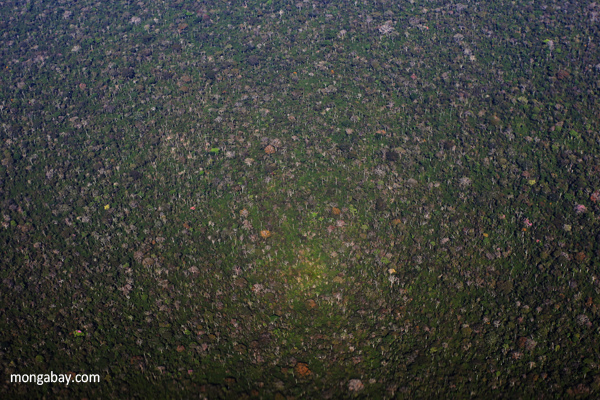 Rainforests in South America have endured three previous extreme global warming events in the past, suggesting they will survive a projected 2-6 degree rise in temperatures over the coming century, reports a study published in the Annual Review of Earth and Planetary Science. The research, published by Carlos Jaramillo and Andrés Cárdenas of the Smithsonian […]
Rainforests in South America have endured three previous extreme global warming events in the past, suggesting they will survive a projected 2-6 degree rise in temperatures over the coming century, reports a study published in the Annual Review of Earth and Planetary Science. The research, published by Carlos Jaramillo and Andrés Cárdenas of the Smithsonian […]
New prehistoric animal named after Johnny Depp due to its ‘scissorhands’
 Half a billion years after an arthropod with long triple claws roamed the shallow Cambrian seas, scientists have named it after Hollywood movie actor, Johnny Depp: Kooteninchela deppi. Depp, known for his versatility as an actor, played Edward Scissorhands—an artificial man with long scissors for hands—in a popular 1990 film. “When I first saw the […]
Half a billion years after an arthropod with long triple claws roamed the shallow Cambrian seas, scientists have named it after Hollywood movie actor, Johnny Depp: Kooteninchela deppi. Depp, known for his versatility as an actor, played Edward Scissorhands—an artificial man with long scissors for hands—in a popular 1990 film. “When I first saw the […]
Industrialized fishing has forced seabirds to change what they eat
 The bleached bones of seabirds are telling us a new story about the far-reaching impacts of industrial fisheries on today’s oceans. Looking at the isotopes of 250 bones from Hawaiian petrels (Pterodroma sandwichensis), scientists have been able to reconstruct the birds’ diets over the last 3,000 years. They found an unmistakable shift from big prey […]
The bleached bones of seabirds are telling us a new story about the far-reaching impacts of industrial fisheries on today’s oceans. Looking at the isotopes of 250 bones from Hawaiian petrels (Pterodroma sandwichensis), scientists have been able to reconstruct the birds’ diets over the last 3,000 years. They found an unmistakable shift from big prey […]
Humans killed over 10 percent of the world’s bird species when they colonized the Pacific Islands
 One of the survivors: the Takahē, a flightless rail from New Zealand. Photo by: © ZSL. Around 4,000 years ago intrepid Polynesian seafarers made their way into an untamed wilderness: the far-flung Pacific Islands. Over a thousands or so years, they rowed from one island to another, stepping on shores never yet seen by humans. […]
One of the survivors: the Takahē, a flightless rail from New Zealand. Photo by: © ZSL. Around 4,000 years ago intrepid Polynesian seafarers made their way into an untamed wilderness: the far-flung Pacific Islands. Over a thousands or so years, they rowed from one island to another, stepping on shores never yet seen by humans. […]
Giant prehistoric freshwater turtle discovered
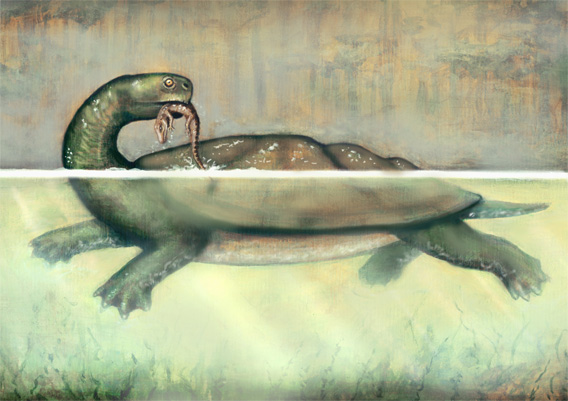 Reconstruction of Carbonemys preying upon a small crocodylomorph. Courtesy of Cadena et al. 2012 Researchers working in Colombia has discovered the fossilized remains of a giant freshwater turtle that lived some 60 million years ago. The turtle, named Carbonemys cofrinii or the “coal turtle”, had a shell measuring 5 feet 7 inches and an overall […]
Reconstruction of Carbonemys preying upon a small crocodylomorph. Courtesy of Cadena et al. 2012 Researchers working in Colombia has discovered the fossilized remains of a giant freshwater turtle that lived some 60 million years ago. The turtle, named Carbonemys cofrinii or the “coal turtle”, had a shell measuring 5 feet 7 inches and an overall […]
Humans killed off magnificent Australian megafauna, flipping rainforest into savannah
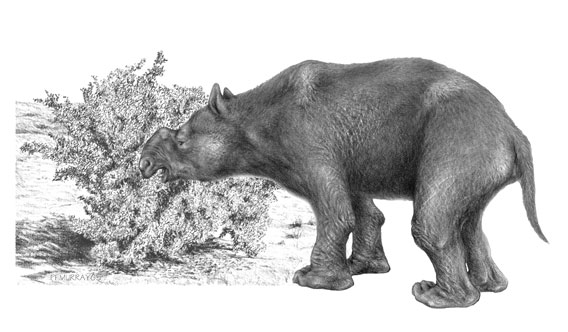 An extinct marsupial mega-herbivore, Diprotodon optatum. Drawing by Peter Murray. Image © Science/AAAS. The theory that humans, and not climate change, was primarily responsible for the extinction of giant marsupials in prehistoric Australia takes another step forward with a new study in Science. Exploring sediment cores for past evidence of big herbivores, researchers found that […]
An extinct marsupial mega-herbivore, Diprotodon optatum. Drawing by Peter Murray. Image © Science/AAAS. The theory that humans, and not climate change, was primarily responsible for the extinction of giant marsupials in prehistoric Australia takes another step forward with a new study in Science. Exploring sediment cores for past evidence of big herbivores, researchers found that […]
Meet the dinosaur that looks like a crow
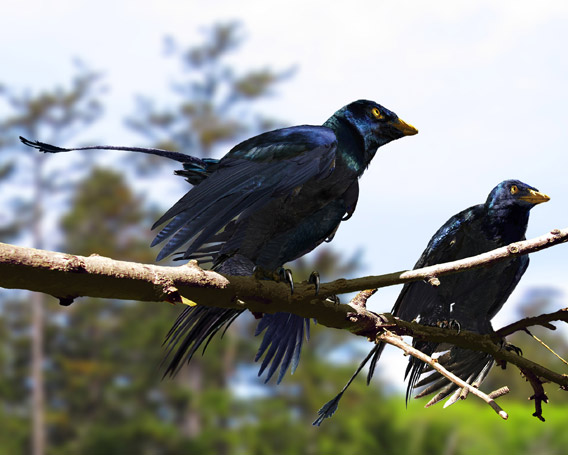 An artist’s recreation of Microraptor, a pigeon-sized, four-winged dinosaur that lived about 130 million years ago. Recent research has shown that the dinosaur had iridescent plumage. Image by: Jason Brougham/University of Texas. The more we discover about dinosaurs, the more these “terrible lizards” resemble otherworldly birds. None more so than the microraptor, which paleontologists have […]
An artist’s recreation of Microraptor, a pigeon-sized, four-winged dinosaur that lived about 130 million years ago. Recent research has shown that the dinosaur had iridescent plumage. Image by: Jason Brougham/University of Texas. The more we discover about dinosaurs, the more these “terrible lizards” resemble otherworldly birds. None more so than the microraptor, which paleontologists have […]
Carbon emissions paving way for mass extinction in oceans
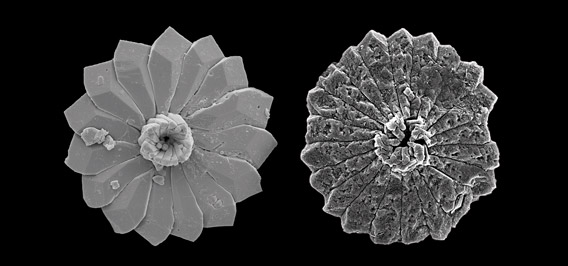 Ocean acidification growing at a rate faster than anytime in 300 million years. To the left a discoaster of marine plankton before an ocean acidification event 56 million years ago, and to the right its counterpart corroded by ocean acidification event. Image taken with a scanning electron microscope (SEM). Human emissions of carbon dioxide may […]
Ocean acidification growing at a rate faster than anytime in 300 million years. To the left a discoaster of marine plankton before an ocean acidification event 56 million years ago, and to the right its counterpart corroded by ocean acidification event. Image taken with a scanning electron microscope (SEM). Human emissions of carbon dioxide may […]
When giant coyotes roamed the Earth
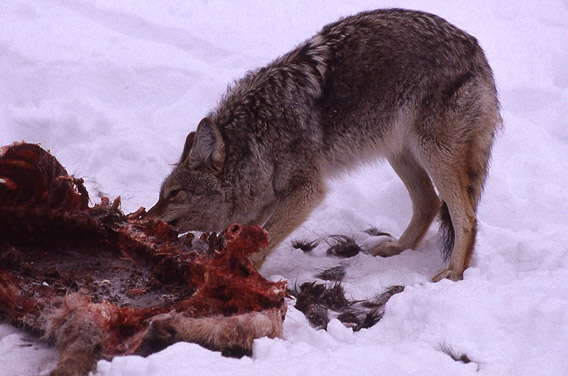 Coyote feeding on elk carcass in Yellowstone National Park. Photo by: Jim Peaco/U.S. National Park Service. Not long ago, geologically speaking, coyotes (Canis latrans) were bigger and more robust than today’s animals. In the late Pleistocene, over 10,000 years ago, coyotes rivaled grey wolves (Canis lupus) in size. But, according to a new paper in […]
Coyote feeding on elk carcass in Yellowstone National Park. Photo by: Jim Peaco/U.S. National Park Service. Not long ago, geologically speaking, coyotes (Canis latrans) were bigger and more robust than today’s animals. In the late Pleistocene, over 10,000 years ago, coyotes rivaled grey wolves (Canis lupus) in size. But, according to a new paper in […]
Paleontologists reconstruct extinct, “elegant” penguin
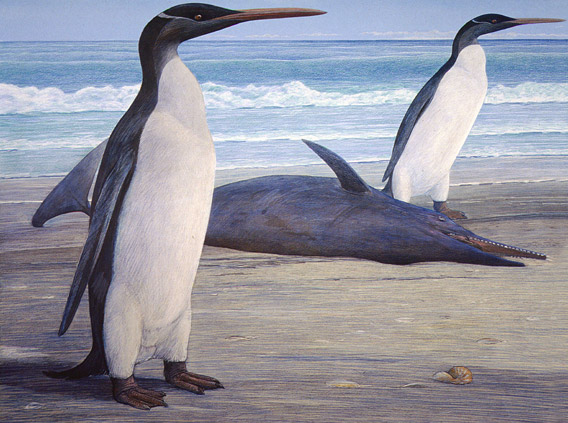 Two Kairuku penguins come ashore, passing a stranded Waipatia dolphin. Artwork by Chris Gaskin, owner and copyright owner: Geology Museum, University of Otago.. Around 25 million years ago a penguin with a long, sharp beak and massive flippers lived in a New Zealand that was almost entirely underwater. The bird, named Kairuku after a Maori […]
Two Kairuku penguins come ashore, passing a stranded Waipatia dolphin. Artwork by Chris Gaskin, owner and copyright owner: Geology Museum, University of Otago.. Around 25 million years ago a penguin with a long, sharp beak and massive flippers lived in a New Zealand that was almost entirely underwater. The bird, named Kairuku after a Maori […]
Jurassic insect sings again
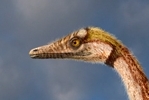 Innovative research has made a long-extinct katydid—which inhabited the world of dinosaurs like stegosaurus, allosaurus, and diplodocus—sing again. The discovery of an incredibly well-preserved fossil of a new species of katydid, dubbed Archaboilus musicus, gave biomechanical experts the opportunity to recreate a song not heard in 165 million years, according to new research published in […]
Innovative research has made a long-extinct katydid—which inhabited the world of dinosaurs like stegosaurus, allosaurus, and diplodocus—sing again. The discovery of an incredibly well-preserved fossil of a new species of katydid, dubbed Archaboilus musicus, gave biomechanical experts the opportunity to recreate a song not heard in 165 million years, according to new research published in […]
2 spesis baru dinosaur, termasuk 15-haiwan bertanduk, telah ditemui di Utah
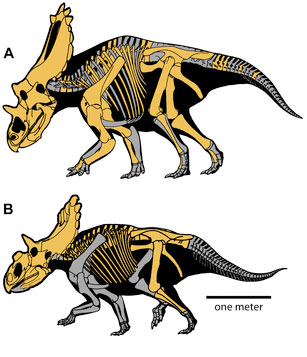 Associated Press melaporkan bahawa saintis telah menemui dua spesis dinosaur di Utah yang sehingga kini belum diketahui spesisnya. Spesis tersebut telah dihuraikan dalam jurnal terbaru PLoS ONE. Kedua-dua spesis tersebut adalah berkaitan dengan Triceratops. Salah satu ialah Kosmocratops richardsoni, mempunyai 15 tanduk di atas kepalanya. Manakala selebihnya ialah Utahceratops, yang hanya mempunyai lima tanduk. Kosmoceratops […]
Associated Press melaporkan bahawa saintis telah menemui dua spesis dinosaur di Utah yang sehingga kini belum diketahui spesisnya. Spesis tersebut telah dihuraikan dalam jurnal terbaru PLoS ONE. Kedua-dua spesis tersebut adalah berkaitan dengan Triceratops. Salah satu ialah Kosmocratops richardsoni, mempunyai 15 tanduk di atas kepalanya. Manakala selebihnya ialah Utahceratops, yang hanya mempunyai lima tanduk. Kosmoceratops […]
2 spesis baru dinosaur, termasuk 15-haiwan bertanduk, telah ditemui di Utah
 Associated Press melaporkan bahawa saintis telah menemui dua spesis dinosaur di Utah yang sehingga kini belum diketahui spesisnya. Spesis tersebut telah dihuraikan dalam jurnal terbaru PLoS ONE. Kedua-dua spesis tersebut adalah berkaitan dengan Triceratops. Salah satu ialah Kosmoceratops richardsoni, mempunyai 15 tanduk di atas kepalanya. Manakala selebihnya ialah Utahceratops gettyi, yang hanya mempunyai lima tanduk. […]
Associated Press melaporkan bahawa saintis telah menemui dua spesis dinosaur di Utah yang sehingga kini belum diketahui spesisnya. Spesis tersebut telah dihuraikan dalam jurnal terbaru PLoS ONE. Kedua-dua spesis tersebut adalah berkaitan dengan Triceratops. Salah satu ialah Kosmoceratops richardsoni, mempunyai 15 tanduk di atas kepalanya. Manakala selebihnya ialah Utahceratops gettyi, yang hanya mempunyai lima tanduk. […]
Interview with conservation legend, Richard Leakey
 Famed paleoanthropologist Richard Leakey envisions the future with a view that remembers the past Looking Back: A family world famous for discovery. Richard Leakey and his parents, Louis and Mary Leakey. Time Magazine cover, featuring Dr Richard Leakey, courtesy of Time Warner. Leakey family photos courtesy of Academy of Achievement.org. Following in his family’s footsteps, […]
Famed paleoanthropologist Richard Leakey envisions the future with a view that remembers the past Looking Back: A family world famous for discovery. Richard Leakey and his parents, Louis and Mary Leakey. Time Magazine cover, featuring Dr Richard Leakey, courtesy of Time Warner. Leakey family photos courtesy of Academy of Achievement.org. Following in his family’s footsteps, […]
Scientists discover giant species of crocodile; luckily it is extinct
 Modern-day Nile crocodile Researchers excavating a coal mine in Colombia have discovered a previously unknown species of prehistoric crocodile. The beast is described in the September 15 issue of the journal Palaeontology. The freswhwater crocodile, named Acherontisuchus guajiraensis, lived some 60 million years ago in swampy habitats shared with Titanoboa, the world’s largest known snake. […]
Modern-day Nile crocodile Researchers excavating a coal mine in Colombia have discovered a previously unknown species of prehistoric crocodile. The beast is described in the September 15 issue of the journal Palaeontology. The freswhwater crocodile, named Acherontisuchus guajiraensis, lived some 60 million years ago in swampy habitats shared with Titanoboa, the world’s largest known snake. […]
Pictures: Scientists discover carnivorous pygmy dinosaur
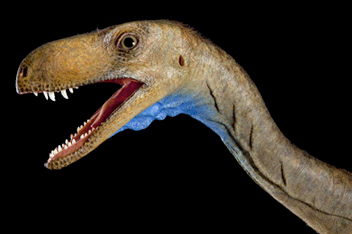 Scientists have announced the discovery of a new species of carnivorous dinosaur which lived 230 million years ago in what is today Argentina. Eodromaeus, which means “dawn runner”, weighed only 10-15 pounds and reached a length of 1.3 meters (4 feet), but it packed a punch with saber-shaped upper teeth for grabbing prey. Scientists believe […]
Scientists have announced the discovery of a new species of carnivorous dinosaur which lived 230 million years ago in what is today Argentina. Eodromaeus, which means “dawn runner”, weighed only 10-15 pounds and reached a length of 1.3 meters (4 feet), but it packed a punch with saber-shaped upper teeth for grabbing prey. Scientists believe […]
Extinct giant stork towered over ‘hobbits’ on Flores
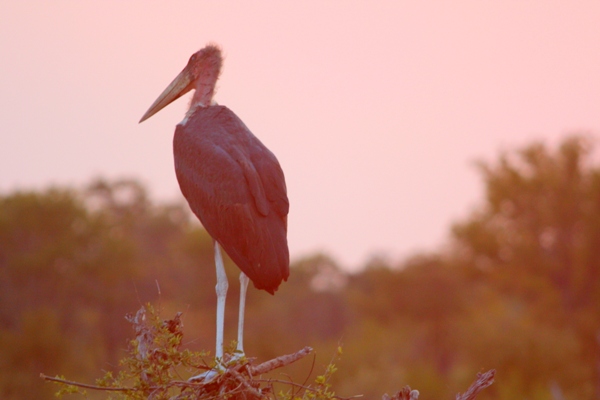 Scientists have discovered an extinct massive stork, standing nearly 6 feet tall (1.8 meter) and weighing 35 pounds (15 kilograms), which would have shared the island of Flores with the ‘hobbits’—dwarf hominin species known as Homo floresiensis—reports the BBC. According to the researchers the meat-eating stork was big enough to prey on young Homo floresiensis, […]
Scientists have discovered an extinct massive stork, standing nearly 6 feet tall (1.8 meter) and weighing 35 pounds (15 kilograms), which would have shared the island of Flores with the ‘hobbits’—dwarf hominin species known as Homo floresiensis—reports the BBC. According to the researchers the meat-eating stork was big enough to prey on young Homo floresiensis, […]
Pictures: Giant prehistoric penguin discovered
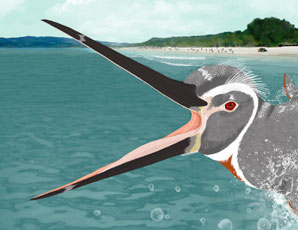 Paleontologists have unearthed fossil remains of a giant species of penguin that roamed the Earth 36 million years ago, according to research published in Science. Excavating a site in Peru, Julia Clarke, of The University of Texas and colleagues, found the first extinct penguin with preserved evidence of scales and feathers. The new species Inkayacu […]
Paleontologists have unearthed fossil remains of a giant species of penguin that roamed the Earth 36 million years ago, according to research published in Science. Excavating a site in Peru, Julia Clarke, of The University of Texas and colleagues, found the first extinct penguin with preserved evidence of scales and feathers. The new species Inkayacu […]
2 new dinosaur species, including 15-horned beast, discovered in Utah
 Scientists discovered two previously unknown species of dinosaur in southern Utah, reports the Associated Press. The species are described in the current issue of the journal PLoS ONE. Both species are closely related to the Triceratops. One, Kosmoceratops richardsoni, had 15 horns on its head, while the other, Utahceratops gettyi, had five. Kosmoceratops richardsoni was […]
Scientists discovered two previously unknown species of dinosaur in southern Utah, reports the Associated Press. The species are described in the current issue of the journal PLoS ONE. Both species are closely related to the Triceratops. One, Kosmoceratops richardsoni, had 15 horns on its head, while the other, Utahceratops gettyi, had five. Kosmoceratops richardsoni was […]
Dwarf dinosaur confirmed: the horse-sized sauropod of Transylvania
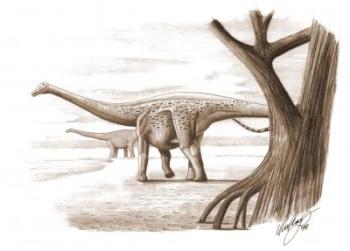 A dinosaur mystery over a hundred years old has been unraveled according to a new study in the Proceedings of the National Academy of Sciences. In 1895 a woman discovered dinosaur bones on her family estate in Transylvania, a region in present-day Romania. Fortunately, her brother was paleontologist Franz Baron Nopsca; he declared that the […]
A dinosaur mystery over a hundred years old has been unraveled according to a new study in the Proceedings of the National Academy of Sciences. In 1895 a woman discovered dinosaur bones on her family estate in Transylvania, a region in present-day Romania. Fortunately, her brother was paleontologist Franz Baron Nopsca; he declared that the […]
Prehistoric snake gobbled-up dinosaur babies
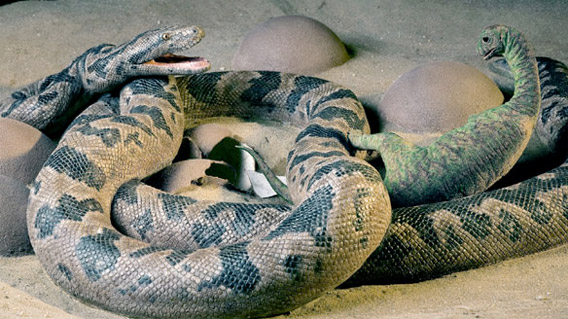 Sauropod babies for breakfast A fossilized snake has been discovered inside a titanosaur nest in India, leading researchers to conclude that the snake fed on newly-hatched dinosaur babies, rather than their eggs like modern snakes. Paleontologist and snake expert Jason Head says that the snake, known as Sanajeh indicus, lacked the wipe-jaws needed to swallow […]
Sauropod babies for breakfast A fossilized snake has been discovered inside a titanosaur nest in India, leading researchers to conclude that the snake fed on newly-hatched dinosaur babies, rather than their eggs like modern snakes. Paleontologist and snake expert Jason Head says that the snake, known as Sanajeh indicus, lacked the wipe-jaws needed to swallow […]
Polar bears are newcomers on the world stage
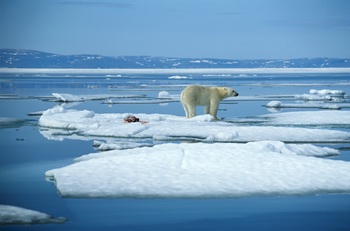 One of the most well-known animals, the polar bear, is a newcomer on the world stage, according to research published in the Proceedings of the National Academy of Sciences. By studying the DNA of an ancient polar bear jawbone uncovered in 2004 in Norway scientists have for the first time pinpointed the time when the […]
One of the most well-known animals, the polar bear, is a newcomer on the world stage, according to research published in the Proceedings of the National Academy of Sciences. By studying the DNA of an ancient polar bear jawbone uncovered in 2004 in Norway scientists have for the first time pinpointed the time when the […]
New study: overhunting by humans killed off Australia’s megafauna
For over a century and a half researchers have debated whether humans or climate change killed off Australia’s megafuana. A new paper in Science argues with new evidence that Australia’s giant marsupials, monstrous reptiles, and large flightless birds were brought to extinction not by an unruly climate, but by the arrival of humans. Employing improved […]
Extinct goat was “similar to crocodiles”
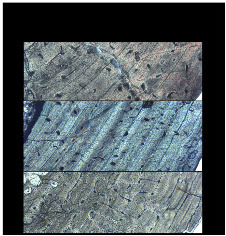 It sounds like something out of Greek mythology: a half-goat, half-reptilian creature. But researchers have discovered that an extinct species of goat, the Balearic Island cave goat or Myotragus balearicus, survived in nutrient-poor Mediterranean islands by evolving reptilian-specific characteristics. The goat, much like crocodiles, was able to grow at flexible rates, stopping growth entirely when […]
It sounds like something out of Greek mythology: a half-goat, half-reptilian creature. But researchers have discovered that an extinct species of goat, the Balearic Island cave goat or Myotragus balearicus, survived in nutrient-poor Mediterranean islands by evolving reptilian-specific characteristics. The goat, much like crocodiles, was able to grow at flexible rates, stopping growth entirely when […]
Arctic lake undergoing unprecedented changes due to warming
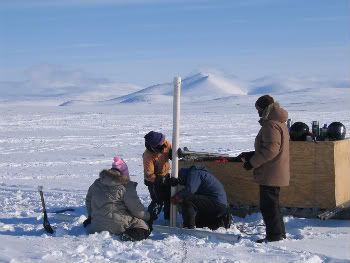 Arctic researcher: ‘we have entered unchartered territory’ The Arctic should be growing cooler, but a new sediment core taken from an Arctic lake reveals that the lake’s ecology and chemistry has been transformed by unnatural warming beginning in the 1950s. The sediment core proves that changes happening in the lake during the Twentieth Century are […]
Arctic researcher: ‘we have entered unchartered territory’ The Arctic should be growing cooler, but a new sediment core taken from an Arctic lake reveals that the lake’s ecology and chemistry has been transformed by unnatural warming beginning in the 1950s. The sediment core proves that changes happening in the lake during the Twentieth Century are […]
Historical deforestation in Madagascar may not be as bad as commonly believed
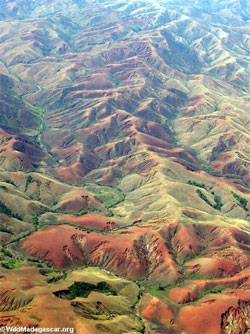 The long-held assumption that Madagascar has lost 90 percent of its forest cover due to fire and slash-and-burn agriculture may be overstated, argues new research published in Conservation Letters. Analyzing 6000-year pollen records in four sites, Malika Virah-Sawmy of Oxford University found evidence that vegetation in southeast Madagascar has for millennia been a mosaic of […]
The long-held assumption that Madagascar has lost 90 percent of its forest cover due to fire and slash-and-burn agriculture may be overstated, argues new research published in Conservation Letters. Analyzing 6000-year pollen records in four sites, Malika Virah-Sawmy of Oxford University found evidence that vegetation in southeast Madagascar has for millennia been a mosaic of […]
Extinction debt can last millions of years
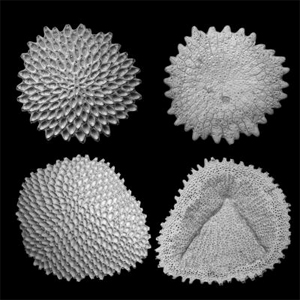 Extinction can be set in motion millions of years before a species’ actual demise, suggesting that present-day drivers of habitat destruction and degradation may have already doomed many species to eventual extinction, report researchers writing in Proceedings of the Royal Society B online. Analyzing the fossil record of microscopic coral-like animals known as cupuladriid bryozoans, […]
Extinction can be set in motion millions of years before a species’ actual demise, suggesting that present-day drivers of habitat destruction and degradation may have already doomed many species to eventual extinction, report researchers writing in Proceedings of the Royal Society B online. Analyzing the fossil record of microscopic coral-like animals known as cupuladriid bryozoans, […]
Age of the Amazon River estimated at 11 million years
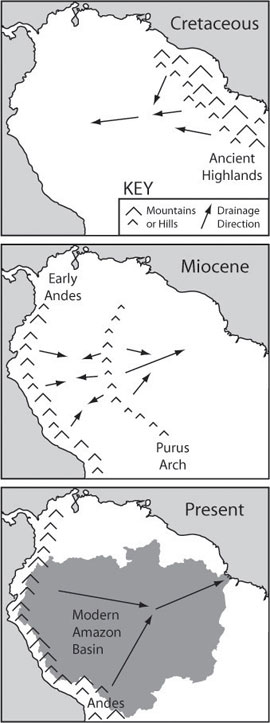 A new study, published in the journal Geology, estimates the age of the Amazon river at 11 million years. Conducting analysis of sedimentological and paleontological data obtained by drilling deep boreholes (up to 4.5 kilometers or 2.8 miles deep) near the mouth of the Amazon, a team of scientists from University of Amsterdam, the University […]
A new study, published in the journal Geology, estimates the age of the Amazon river at 11 million years. Conducting analysis of sedimentological and paleontological data obtained by drilling deep boreholes (up to 4.5 kilometers or 2.8 miles deep) near the mouth of the Amazon, a team of scientists from University of Amsterdam, the University […]
Permian mass extinction caused by giant volcanic eruption
Two hundred and sixty million years ago the Earth experienced its worst mass extinction: 95 percent of marine life and 70 percent of terrestrial life vanished. Long a subject of dispute, researchers from the University of Leeds believe they have confirmed the reason behind the so-called Permian extinction. A giant volcanic eruption in what is […]
48 ‘new’ species of dinosaur discovered
Monstrous prehistoric snake provides glimpse of warmer tropical forests
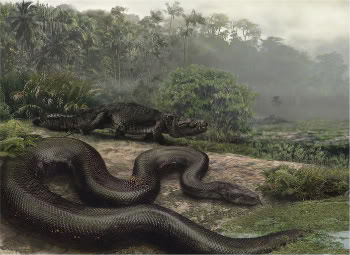
World’s largest snake discovered: prehistoric serpent was twice the size of an anaconda

Did cheetah come from China?
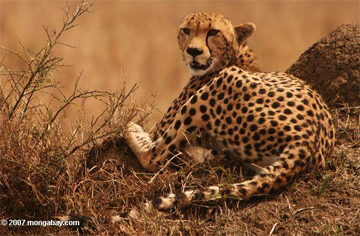
Missing link between fish and land animals discovered
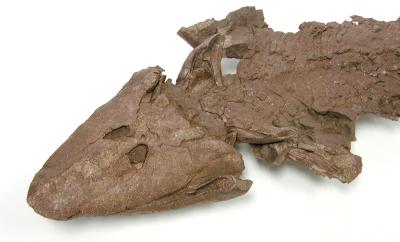 Missing link between fish and land animals discovered Missing link between fish and land animals discovered By Morgan Erickson-Davis, special to mongabay.com November 7, 2008 New fossil brings more insight into vertebrates’ transition to life on land
Missing link between fish and land animals discovered Missing link between fish and land animals discovered By Morgan Erickson-Davis, special to mongabay.com November 7, 2008 New fossil brings more insight into vertebrates’ transition to life on land
Past climate change drove mass extinction in Pakistan
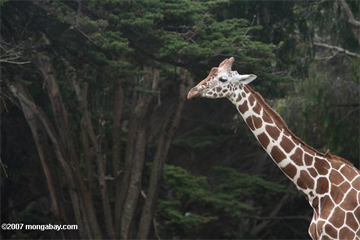 Past climate change drove mass extinction in Pakistan Past climate change drove mass extinction in Pakistan Jeremy Hance, mongabay.com September 26, 2008 Past climate change cut mammal biodiversity by over half in lost ecosystem Research on long-vanished mammals in the Siwalik region of Northern Pakistan has yielded results relevant for today. In the span of […]
Past climate change drove mass extinction in Pakistan Past climate change drove mass extinction in Pakistan Jeremy Hance, mongabay.com September 26, 2008 Past climate change cut mammal biodiversity by over half in lost ecosystem Research on long-vanished mammals in the Siwalik region of Northern Pakistan has yielded results relevant for today. In the span of […]
Researchers devise new comparison of mass extinction events
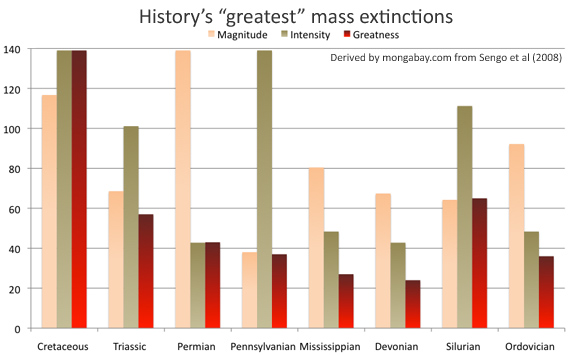 Researchers devise new comparison of mass extinction events Researchers devise new comparison of mass extinction events mongabay.com September 2, 2008 Researchers have created a new way to compare historical mass extinction events. The scoring system, presented in the early online edition of the journal Proceedings of the National Academy of Sciences, works by multiplying the […]
Researchers devise new comparison of mass extinction events Researchers devise new comparison of mass extinction events mongabay.com September 2, 2008 Researchers have created a new way to compare historical mass extinction events. The scoring system, presented in the early online edition of the journal Proceedings of the National Academy of Sciences, works by multiplying the […]
Humans – not climate – drove extinction of giant Tasmanian animals
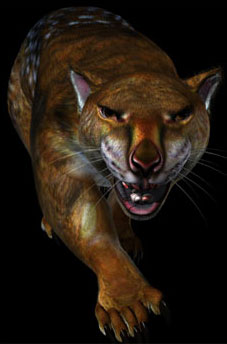 Humans – not climate – drove extinction of giant Tasmanian animals Humans – not climate – drove extinction of giant Tasmanian animals mongabay.com August 11, 2008 Humans — not climate change — were responsible for the mass extinction of Australia’s megafauna, according to a new study published this week in the journal Proceedings of the […]
Humans – not climate – drove extinction of giant Tasmanian animals Humans – not climate – drove extinction of giant Tasmanian animals mongabay.com August 11, 2008 Humans — not climate change — were responsible for the mass extinction of Australia’s megafauna, according to a new study published this week in the journal Proceedings of the […]
Humans, and global warming, responsible for extinction of mammoths
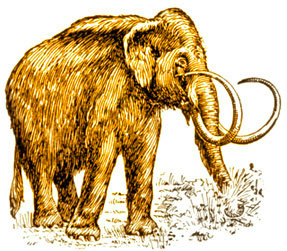 Humans and global warming responsible for extinction of mammoths Humans and global warming responsible for extinction of mammoths mongabay.com March 31, 2008 Study confirms that habitat fragmentation, caused by climate change, split species into small populations, making them more vulnerable to extinction. The combination of human hunting pressure and climate change was responsible for the […]
Humans and global warming responsible for extinction of mammoths Humans and global warming responsible for extinction of mammoths mongabay.com March 31, 2008 Study confirms that habitat fragmentation, caused by climate change, split species into small populations, making them more vulnerable to extinction. The combination of human hunting pressure and climate change was responsible for the […]
10-pound ‘Giant Frog From Hell’ discovered in Madagascar
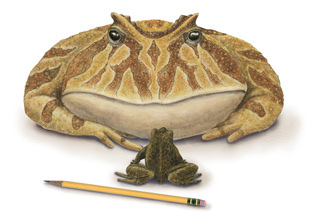 10-pound ‘Giant Frog From Hell’ ate baby dinosaurs 10-pound ‘Giant Frog From Hell’ discovered in Madagascar mongabay.com February 18, 2008 Researchers have discovered the remains of what may be the largest frog ever to exist. Working in Madagascar, scientists led by Stony Brook University paleontologist Dr. David Krause found the remains of a 16-inch, 10-pound […]
10-pound ‘Giant Frog From Hell’ ate baby dinosaurs 10-pound ‘Giant Frog From Hell’ discovered in Madagascar mongabay.com February 18, 2008 Researchers have discovered the remains of what may be the largest frog ever to exist. Working in Madagascar, scientists led by Stony Brook University paleontologist Dr. David Krause found the remains of a 16-inch, 10-pound […]
New duck-billed dinosaur discovered in Mexico
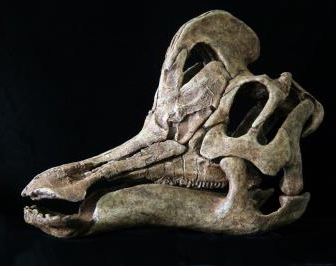 New duck-billed dinosaur discovered in Mexico New duck-billed dinosaur discovered in Mexico mongabay.com February 12, 2008 A previously unknown species of dinosaur has been discovered in Mexico, shadding new light on the history of western North America, report researchers from the Utah Museum of Natural History at the University of Utah. The 72-million-year-old ago beast, […]
New duck-billed dinosaur discovered in Mexico New duck-billed dinosaur discovered in Mexico mongabay.com February 12, 2008 A previously unknown species of dinosaur has been discovered in Mexico, shadding new light on the history of western North America, report researchers from the Utah Museum of Natural History at the University of Utah. The 72-million-year-old ago beast, […]
Two strange carnivorous dinosaurs discovered in the Sahara
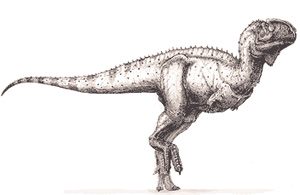 Two strange carnivorous dinosaurs discovered in the Sahara Two strange carnivorous dinosaurs discovered in the Sahara mongabay.com February 13, 2008 Two previously unknown species of dinosaur discovered in the Sahara were unusual meat-eaters, report scientists from the University of Chicago and the University of Bristol. Short-snouted Kryptops palaios, or “old hidden face,” was named for […]
Two strange carnivorous dinosaurs discovered in the Sahara Two strange carnivorous dinosaurs discovered in the Sahara mongabay.com February 13, 2008 Two previously unknown species of dinosaur discovered in the Sahara were unusual meat-eaters, report scientists from the University of Chicago and the University of Bristol. Short-snouted Kryptops palaios, or “old hidden face,” was named for […]
Mini-pterodactyl discovered in China
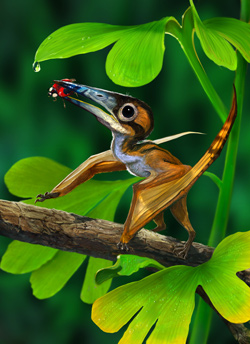 Mini-pterodactyl discovered in China Mini-pterodactyl discovered in China mongabay.com February 11, 2008 Scientists have discovered a previously unknown species of pterodactyl in northeastern China. Life reconstructions of Nemicolopterus crypticus, a small derived flying reptile that lived in the gingko forests that existed some 120 million years ago in present China. Top image courtesy of Chuang […]
Mini-pterodactyl discovered in China Mini-pterodactyl discovered in China mongabay.com February 11, 2008 Scientists have discovered a previously unknown species of pterodactyl in northeastern China. Life reconstructions of Nemicolopterus crypticus, a small derived flying reptile that lived in the gingko forests that existed some 120 million years ago in present China. Top image courtesy of Chuang […]
Global warming to increase insect attacks on plants
 Global warming to increase insect attacks on plants Global warming to increase insect attacks on plants mongabay.com February 11, 2008 Global warming will increase attacks on plant leaves by insects, reports a study published in Proceedings of the National Academy of Sciences. Analyzing more than 5,000 fossilized leaves dating from the Paleocene-Eocene Thermal Maximum (PETM), […]
Global warming to increase insect attacks on plants Global warming to increase insect attacks on plants mongabay.com February 11, 2008 Global warming will increase attacks on plant leaves by insects, reports a study published in Proceedings of the National Academy of Sciences. Analyzing more than 5,000 fossilized leaves dating from the Paleocene-Eocene Thermal Maximum (PETM), […]
Recovery from worst mass extinction took 30M years
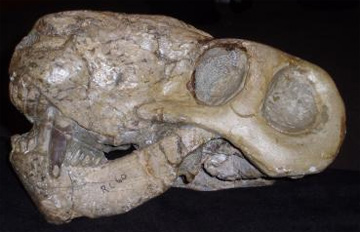 Recovery from worst mass extinction took 30 million years Recovery from worst mass extinction took 30 million years mongabay.com January 20, 2008 The recovery of complex ecosystems following history’s worst mass extinction took 30 million years reports a study published last week in Proceedings of the Royal Society B. Analyzing the recovery of tetrapods — […]
Recovery from worst mass extinction took 30 million years Recovery from worst mass extinction took 30 million years mongabay.com January 20, 2008 The recovery of complex ecosystems following history’s worst mass extinction took 30 million years reports a study published last week in Proceedings of the Royal Society B. Analyzing the recovery of tetrapods — […]
2,000 pound rodent discovered
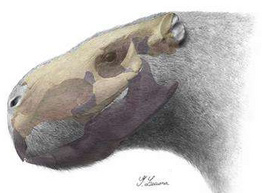 2,000 pound rodent discovered 2,000 pound rodent discovered mongabay.com January 16, 2008 Scientists have discovered the remains of an extinct 2,000 pound rodent — the largest rodent ever known. The find is described Wednesday in Britain’s Proceedings of the Royal Society. “We report the discovery of an exceptionally well preserved fossil skull of a new […]
2,000 pound rodent discovered 2,000 pound rodent discovered mongabay.com January 16, 2008 Scientists have discovered the remains of an extinct 2,000 pound rodent — the largest rodent ever known. The find is described Wednesday in Britain’s Proceedings of the Royal Society. “We report the discovery of an exceptionally well preserved fossil skull of a new […]
Despite Arctic crocodiles, glaciers existed during extreme global warming 90M years ago
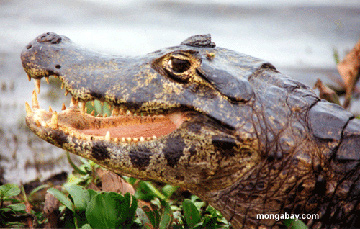 Despite crocs in the Arctic, glaciers existed during extreme warming 90M years ago Despite Arctic crocodiles, glaciers existed during extreme global warming 90M years ago mongabay.com January 10, 2008 Massive glaciers extended across 50-60 percent of Antarctica some 91.2 million years even as crocodiles roamed the Arctic and surface temperatures of the western tropical Atlantic […]
Despite crocs in the Arctic, glaciers existed during extreme warming 90M years ago Despite Arctic crocodiles, glaciers existed during extreme global warming 90M years ago mongabay.com January 10, 2008 Massive glaciers extended across 50-60 percent of Antarctica some 91.2 million years even as crocodiles roamed the Arctic and surface temperatures of the western tropical Atlantic […]
Evolution of whales challenged
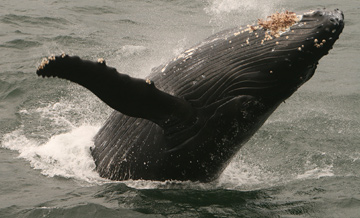 Evolution of whales challenged Origin of whales challenged mongabay.com December 19, 2007 Modern whales appear to have evolved from a raccoon-sized creature with the body of a small deer, according to scientists writing in the journal Nature. The results challenge the theory that cetaceans are descended from even-toed ungulates (artiodactyls) like hippos, as previous molecular […]
Evolution of whales challenged Origin of whales challenged mongabay.com December 19, 2007 Modern whales appear to have evolved from a raccoon-sized creature with the body of a small deer, according to scientists writing in the journal Nature. The results challenge the theory that cetaceans are descended from even-toed ungulates (artiodactyls) like hippos, as previous molecular […]
Prehistoric Carnivorous Fungi Lassoed its Prey
Prehistoric Carnivorous Fungi Lassoed its Prey Prehistoric Carnivorous Fungi Lassoed its Prey mongabay.com December 13, 2007 Scientists have discovered the oldest known carnivorous fungus, according to a study published in Science. The 100 million-year-old fungus, found trapped in amber, employed sticky loop-like projections to snare its nematode prey. The authors, led by Alexander Schmidt from […]
Massive carnivorous dinosaur discovered
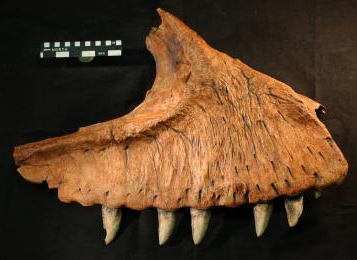 Massive carnivorous dinosaur discovered Massive carnivorous dinosaur discovered mongabay.com December 11, 2007 A massive carnivorous dinosaur discovered in Niger has been described as a new species, according to research published in current issue of the Journal of Vertebrate Paleontology. Carcharodontosaurus iguidensis, as the species is known, is one of the largest carnivorous dinosaurs ever found, […]
Massive carnivorous dinosaur discovered Massive carnivorous dinosaur discovered mongabay.com December 11, 2007 A massive carnivorous dinosaur discovered in Niger has been described as a new species, according to research published in current issue of the Journal of Vertebrate Paleontology. Carcharodontosaurus iguidensis, as the species is known, is one of the largest carnivorous dinosaurs ever found, […]
Global warming may provoke evolution
 Global warming may provoke evolution Global warming may provoke evolution mongabay.com November 26, 2007 Some 80 million years ago, during a period of global warming, a group of relatively immobile salamanders trekked from western North America to the continent that became Asia, report researchers writing in this week’s issue of the journal Proceedings of the […]
Global warming may provoke evolution Global warming may provoke evolution mongabay.com November 26, 2007 Some 80 million years ago, during a period of global warming, a group of relatively immobile salamanders trekked from western North America to the continent that became Asia, report researchers writing in this week’s issue of the journal Proceedings of the […]
Cow-like dinosaur discovered
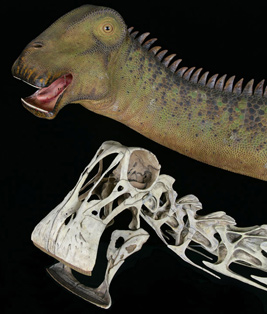 Cow-like dinosaur discovered Cow-like dinosaur discovered mongabay.com November 15, 2007 A dinosaur discovered in the Sahara had a mouth that worked like a vacuum cleaner and operated more like a “Mesozoic cow” than a reptile, report researchers writing in today’s issue of the journal PLoS ONE. Conducting CT scans on Nigersaurus taqueti–as the beast is […]
Cow-like dinosaur discovered Cow-like dinosaur discovered mongabay.com November 15, 2007 A dinosaur discovered in the Sahara had a mouth that worked like a vacuum cleaner and operated more like a “Mesozoic cow” than a reptile, report researchers writing in today’s issue of the journal PLoS ONE. Conducting CT scans on Nigersaurus taqueti–as the beast is […]
Missing link between humans and apes possibly discovered
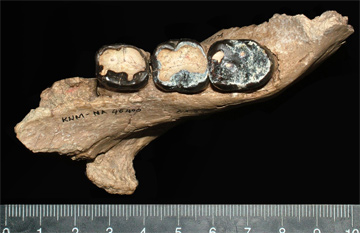 Missing link between humans and apes possibly discovered Missing link between humans and apes possibly discovered mongabay.com November 12, 2007 A 10 million-year-old jawbone discovered in Kenya may represent a new species very close to the last common ancestor of gorillas, chimpanzees, and humans, report researchers writing in the current issue of the journal Proceedings […]
Missing link between humans and apes possibly discovered Missing link between humans and apes possibly discovered mongabay.com November 12, 2007 A 10 million-year-old jawbone discovered in Kenya may represent a new species very close to the last common ancestor of gorillas, chimpanzees, and humans, report researchers writing in the current issue of the journal Proceedings […]
Climate change did not cause extinction of Neanderthals
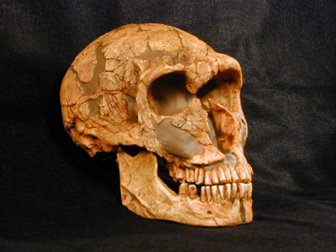 Climate change did not cause extinction of Neanderthals Climate change did not cause extinction of Neanderthals mongabay.com September 12, 2007 Researchers in Europe have found evidence that rules out a “single climatic event” as a factor in the extinction of Neanderthals. Mapping radiocarbon dates of Neanderthal bones from Gorham’s Cave in Gibraltar directly onto a […]
Climate change did not cause extinction of Neanderthals Climate change did not cause extinction of Neanderthals mongabay.com September 12, 2007 Researchers in Europe have found evidence that rules out a “single climatic event” as a factor in the extinction of Neanderthals. Mapping radiocarbon dates of Neanderthal bones from Gorham’s Cave in Gibraltar directly onto a […]
Climate change drove human evolution
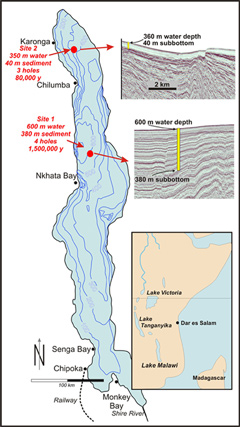 Climate change drove human evolution Climate change drove human evolution mongabay.com September 3, 2007 Climate change appears to have been a significant driver of human evolution, report researchers writing in this week’s issue of the journal Proceedings of the National Academy of Science (PNAS). Studying deep sediment cores from Lake Malawi in Africa, Syracuse University […]
Climate change drove human evolution Climate change drove human evolution mongabay.com September 3, 2007 Climate change appears to have been a significant driver of human evolution, report researchers writing in this week’s issue of the journal Proceedings of the National Academy of Science (PNAS). Studying deep sediment cores from Lake Malawi in Africa, Syracuse University […]
Orchids may have co-existed with dinosaurs
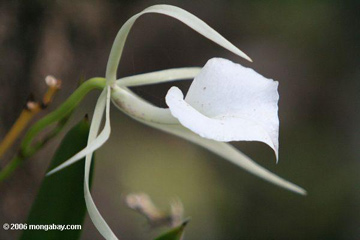 Oldest orchid discovered; suggests flower co-existed with dinosaurs Orchids may have co-existed with dinosaurs mongabay.com August 29, 2007 Orchids are old enough to have co-existed with dinosaurs, report Harvard University scientists. Writing in the journal Nature, the researchers found the earliest evidence of pollination on the fossil record by examining the remains of an ancient […]
Oldest orchid discovered; suggests flower co-existed with dinosaurs Orchids may have co-existed with dinosaurs mongabay.com August 29, 2007 Orchids are old enough to have co-existed with dinosaurs, report Harvard University scientists. Writing in the journal Nature, the researchers found the earliest evidence of pollination on the fossil record by examining the remains of an ancient […]
T. rex could outrun a human athlete
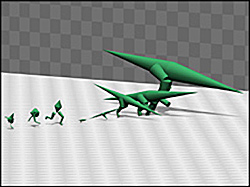 T. rex could outrun a human athlete T. rex could outrun a human athlete mongabay.com August 22, 2007 T. rex could reach speeds of up to 18mph, according to new supercomputer simulations that are believed to be the most accurate projections ever produced. However T. rex could be easily outrun by the smaller Compsognathus, which […]
T. rex could outrun a human athlete T. rex could outrun a human athlete mongabay.com August 22, 2007 T. rex could reach speeds of up to 18mph, according to new supercomputer simulations that are believed to be the most accurate projections ever produced. However T. rex could be easily outrun by the smaller Compsognathus, which […]
Asians played larger role in colonization of Europe than Africans
Asians played larger role in colonization of Europe than Africans Asians played larger role in colonization of Europe than Africans mongabay.com August 6, 2007 Humans with Asian origins played a larger role than those from Africa in colonizing Europe millions of years ago, reports a paper published in the early online edition of the journal […]
Dinosaurs’ rise to dominance was a gradual
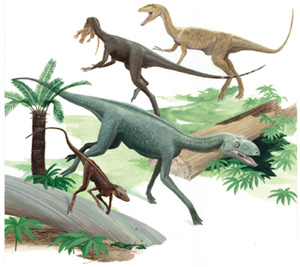 Dinosaurs’ rise to dominance was a gradual Dinosaurs’ rise to dominance was a gradual mongabay.com July 19, 2007 Dinosaurs’ rise to dominance was a gradual rather than sudden, suggests new research published in Science. This scene depicts four dinosaurs and dinosaur precursors from the Hayden Quarry of northern New Mexico. The coexistence during the Late […]
Dinosaurs’ rise to dominance was a gradual Dinosaurs’ rise to dominance was a gradual mongabay.com July 19, 2007 Dinosaurs’ rise to dominance was a gradual rather than sudden, suggests new research published in Science. This scene depicts four dinosaurs and dinosaur precursors from the Hayden Quarry of northern New Mexico. The coexistence during the Late […]
Peanuts, cotton, squash first farmed in Peru 6,000-10,000 years ago
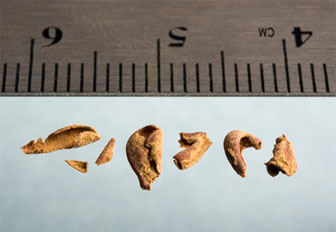 Peanuts, cotton, squash first farmed in Peru 6,000-10,000 years ago Peanuts, cotton, squash first farmed in Peru 6,000-10,000 years ago mongabay.com June 28, 2007 Anthropologists have discovered the earliest-known evidence of peanut, cotton and squash farming. The study, which show that the crops were grown in the Peruvian Andes 5,000-10,000 years ago, is published in […]
Peanuts, cotton, squash first farmed in Peru 6,000-10,000 years ago Peanuts, cotton, squash first farmed in Peru 6,000-10,000 years ago mongabay.com June 28, 2007 Anthropologists have discovered the earliest-known evidence of peanut, cotton and squash farming. The study, which show that the crops were grown in the Peruvian Andes 5,000-10,000 years ago, is published in […]
Past global warming produced monster penguins
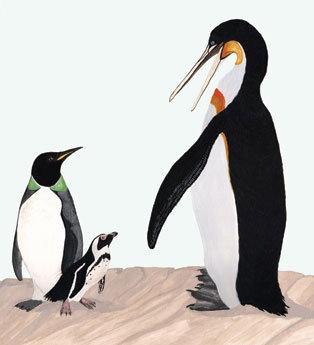 Past global warming produced giant penguins Past global warming produced monster penguins mongabay.com June 25, 2007 Scientists have discovered fossil remains of a giant species of penguin that lived some 40 million years ago in what is now Peru. Coupled with the finding of a smaller species from the same time period, the remains reveal […]
Past global warming produced giant penguins Past global warming produced monster penguins mongabay.com June 25, 2007 Scientists have discovered fossil remains of a giant species of penguin that lived some 40 million years ago in what is now Peru. Coupled with the finding of a smaller species from the same time period, the remains reveal […]
Highly carnivorous wolves in Alaska killed by global warming
Highly carnivorous wolves in Alaska killed by global warming Highly carnivorous wolves in Alaska killed by global warming mongabay.com June 21, 2007 Researchers have identified a previously unknown species of “highly carnivorous” wolf in Alaska that appears to have died off during the Pleistocene extinction some 12,000 years ago. The results are published in the […]
Pygmy panda discovered in China
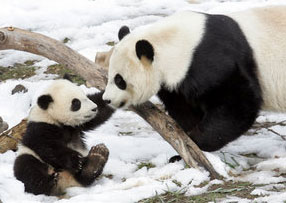 Pygmy panda discovered in China Pygmy panda discovered in China mongabay.com June 18, 2007 Researchers have discovered an extinct pygmy panda in what were once the tropical forests of China. Writing in the June 18 early online edition of the journal Proceedings of the National Academy of Sciences, an international team of scientists describe the […]
Pygmy panda discovered in China Pygmy panda discovered in China mongabay.com June 18, 2007 Researchers have discovered an extinct pygmy panda in what were once the tropical forests of China. Writing in the June 18 early online edition of the journal Proceedings of the National Academy of Sciences, an international team of scientists describe the […]
Ancient gliding reptile discovered
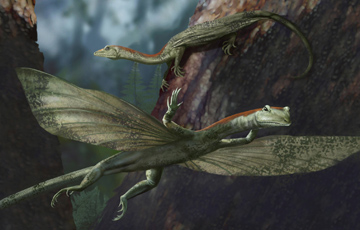 Ancient gliding reptile discovered Ancient gliding reptile discovered Society of Vertebrate Paleontology June 12, 2007 A remarkable new long-necked, gliding reptile discovered in 220 million-year old sediments of eastern north America is described in the latest issue of the Journal of Vertebrate Paleontology (Vol. 27, No. 2), scientists report. Mecistotrachelos apeoros (meaning “soaring, long-necked”) is […]
Ancient gliding reptile discovered Ancient gliding reptile discovered Society of Vertebrate Paleontology June 12, 2007 A remarkable new long-necked, gliding reptile discovered in 220 million-year old sediments of eastern north America is described in the latest issue of the Journal of Vertebrate Paleontology (Vol. 27, No. 2), scientists report. Mecistotrachelos apeoros (meaning “soaring, long-necked”) is […]
Tyrannosaurus rex was slow
Tyrannosaurus rex was slow Tyrannosaurus rex was slow mongabay.com June 7, 2007 Tyrannosaurus rex was a slow, lumbering beast according to new research published in the Journal of Theoretical Biology. The research, led by biomechanics expert John Hutchinson, dispels the notion that T. rex was capable of running at speeds up to 45 miles per […]
Prehistoric bear-like beast discovered in North Dakota
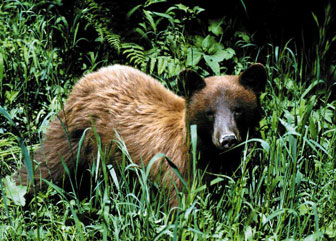 Prehistoric bear-like beast discovered in North Dakota Prehistoric bear-like beast discovered in North Dakota mongabay.com May 24, 2007 The skeleton of a 60-million year old bear-like beat was discovered at an oil drilling site in the North Dakota Badlands, reports the Associated Press (A.P.). State paleontologist John Hoganson said the titanoides fossil was discovered in […]
Prehistoric bear-like beast discovered in North Dakota Prehistoric bear-like beast discovered in North Dakota mongabay.com May 24, 2007 The skeleton of a 60-million year old bear-like beat was discovered at an oil drilling site in the North Dakota Badlands, reports the Associated Press (A.P.). State paleontologist John Hoganson said the titanoides fossil was discovered in […]
Possible baby dinosaur tracks discovered near Denver
Possible baby dinosaur tracks discovered near Denver Possible baby dinosaur tracks discovered near Denver mongabay.com May 24, 2007 A researcher may have discovered “incredibly rare” dinosaur tracks of baby stegosaurs near downtown Denver, reports the Denver Post. Matt Mossbrucker, director of the Morrison Natural History Museum, said the tracks were unearthed in the foothills west […]
Dinosaurs could swim
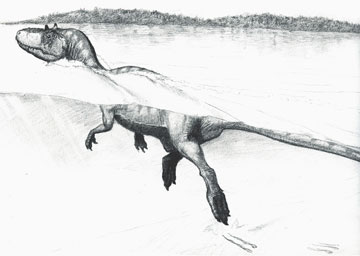 Dinosaurs could swim Dinosaurs could swim mongabay.com May 24, 2007 Researchers found evidence that terrestrial dinosaurs were capable of swimming. Examining fossilized footmarks left on the floor of an ancient lake bed in northern Spain 125 million years ago, scientists led by Loic Costeur of the Universite de Nantes in France said the tracks were […]
Dinosaurs could swim Dinosaurs could swim mongabay.com May 24, 2007 Researchers found evidence that terrestrial dinosaurs were capable of swimming. Examining fossilized footmarks left on the floor of an ancient lake bed in northern Spain 125 million years ago, scientists led by Loic Costeur of the Universite de Nantes in France said the tracks were […]
Largest dinosaur bones in Australia discovered
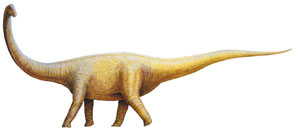 Largest dinosaur bones in Australia discovered Largest dinosaur bones in Australia discovered Queensland Museum May 3, 2007 The largest bones of any dinosaur known in Australia went on display at the Queensland Museum for the first time today. Arts Minister Rod Welford said the internationally-significant fossils were the first dinosaur discovery in south-west Queensland and […]
Largest dinosaur bones in Australia discovered Largest dinosaur bones in Australia discovered Queensland Museum May 3, 2007 The largest bones of any dinosaur known in Australia went on display at the Queensland Museum for the first time today. Arts Minister Rod Welford said the internationally-significant fossils were the first dinosaur discovery in south-west Queensland and […]
Researchers find Earth’s first rainforest
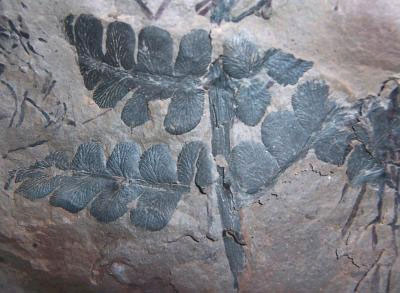 Researchers find Earth’s first rainforest Researchers find Earth’s first rainforest University of Bristol April 23, 2007 A spectacular fossilised forest has transformed our understanding of the ecology of the Earth’s first rainforests. It is 300 million years old. The forest is composed of a bizarre mixture of extinct plants: abundant club mosses, more than 40 […]
Researchers find Earth’s first rainforest Researchers find Earth’s first rainforest University of Bristol April 23, 2007 A spectacular fossilised forest has transformed our understanding of the ecology of the Earth’s first rainforests. It is 300 million years old. The forest is composed of a bizarre mixture of extinct plants: abundant club mosses, more than 40 […]
World’s first rainforest found in Illinois
 World’s first rainforest found in Illinois World’s first rainforest found in Illinois mongabay.com April 23, 2007 Earth’s first rainforest has been found in an Illinois coalmine, according to research published in Geology. The 300 million year fossilized forest consists of a mix of extinct plants including a 130-foot high (40 meter) canopy of club mosses, […]
World’s first rainforest found in Illinois World’s first rainforest found in Illinois mongabay.com April 23, 2007 Earth’s first rainforest has been found in an Illinois coalmine, according to research published in Geology. The 300 million year fossilized forest consists of a mix of extinct plants including a 130-foot high (40 meter) canopy of club mosses, […]
First amphibians were biters not suckers
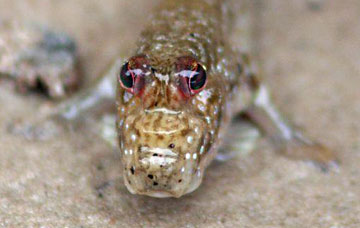 First amphibians were biters not suckers First amphibians were biters not suckers mongabay.com April 16, 2007 Prehistoric aquatic amphibians developed the ability to feed on land well before they became terrestrial reports a new study in the early online edition of Proceedings of the National Academy of Sciences (PNAS). The research, conducted by Harvard University […]
First amphibians were biters not suckers First amphibians were biters not suckers mongabay.com April 16, 2007 Prehistoric aquatic amphibians developed the ability to feed on land well before they became terrestrial reports a new study in the early online edition of Proceedings of the National Academy of Sciences (PNAS). The research, conducted by Harvard University […]
Dinosaur extinction didn’t produce current mammal evolution
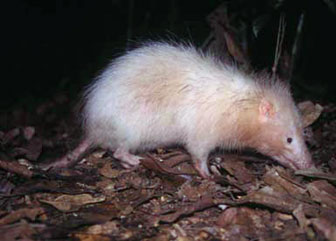 Dinosaur extinction didn’t produce current mammal evolution Dinosaur extinction didn’t produce current mammal evolution mongabay.com March 28, 2007 A new Nature study argues that the demise of dinosaurs did not fuel the rise of mammals. Devising a new ‘tree of life’ for 4,500 species of mammals using molecular evolutionary trees, an international team of researchers […]
Dinosaur extinction didn’t produce current mammal evolution Dinosaur extinction didn’t produce current mammal evolution mongabay.com March 28, 2007 A new Nature study argues that the demise of dinosaurs did not fuel the rise of mammals. Devising a new ‘tree of life’ for 4,500 species of mammals using molecular evolutionary trees, an international team of researchers […]
Evolutionary precursor to snake discovered
Evolutionary precursor to snake discovered Evolutionary precursor to snake discovered Fossil discovery marks earliest record of limbloss in ancient lizard By Phoebe Dey, University of Alberta March 23, 2007 A University of Alberta paleontologist has helped discover the existence of a 95 million-year-old snakelike marine animal, a finding that provides not only the earliest example […]
Newly discovered burrowing dinosaur loved its offspring
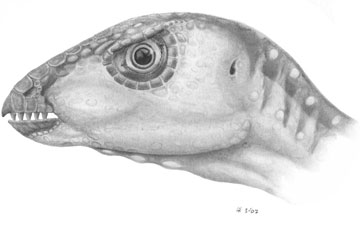 Newly discovered burrowing dinosaur loved its offspring Newly discovered burrowing dinosaur loved its offspring mongabay.com March 20, 2007 The first known burrowing dinosaur has been discovered in southwest Montana, according to a paleontologist at Montana State University. The finding, published in the journal Proceedings of The Royal Society B: Biological Sciences, may shed light on […]
Newly discovered burrowing dinosaur loved its offspring Newly discovered burrowing dinosaur loved its offspring mongabay.com March 20, 2007 The first known burrowing dinosaur has been discovered in southwest Montana, according to a paleontologist at Montana State University. The finding, published in the journal Proceedings of The Royal Society B: Biological Sciences, may shed light on […]
Prehistoric lizard glided through air using ribs
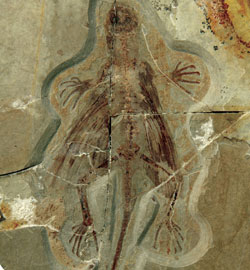 Prehistoric lizard glided through air using ribs Prehistoric lizard glided through air using ribs mongabay.com March 19, 2007 An extinct species of lizard used a wing-like membrane supported by the animal’s elongated ribs for gliding through the air according to Chinese researchers. Gliding lizard fossil (Xianglong zhaoi). The 15.5-cm long skeleton was found in the […]
Prehistoric lizard glided through air using ribs Prehistoric lizard glided through air using ribs mongabay.com March 19, 2007 An extinct species of lizard used a wing-like membrane supported by the animal’s elongated ribs for gliding through the air according to Chinese researchers. Gliding lizard fossil (Xianglong zhaoi). The 15.5-cm long skeleton was found in the […]
Caribbean coral reefs result of mass extinction, rise of isthmus
 Caribbean coral reefs result of mass extinction, rise of isthmus Caribbean coral reefs result of mass extinction, rise of isthmus Research suggests extinction may be gradual and unpredictable mongabay.com March 12, 2007 Extinctions that resulted from the formation of the Panamanian isthmus were delayed two million years according to a new study by researchers at […]
Caribbean coral reefs result of mass extinction, rise of isthmus Caribbean coral reefs result of mass extinction, rise of isthmus Research suggests extinction may be gradual and unpredictable mongabay.com March 12, 2007 Extinctions that resulted from the formation of the Panamanian isthmus were delayed two million years according to a new study by researchers at […]
Ancient humanoids were short and nasty for kung fu fighting, not climbing
 Ancient humanoids were short for fighting, not climbing Ancient humanoids were short and nasty for kung fu fighting, not climbing mongabay.com March 12, 2007 Ancient ape-like human ancestors called as australopiths were short-legged to help them fight, not to climb trees, argues a new study from a researcher at the University of Utah. “The old […]
Ancient humanoids were short for fighting, not climbing Ancient humanoids were short and nasty for kung fu fighting, not climbing mongabay.com March 12, 2007 Ancient ape-like human ancestors called as australopiths were short-legged to help them fight, not to climb trees, argues a new study from a researcher at the University of Utah. “The old […]
Prehistoric spiky freakshow discovered in rock
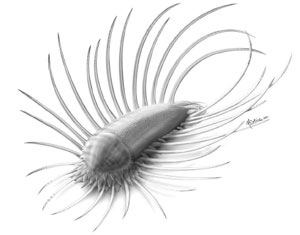 Prehistoric spiky freakshow discovered in rock Prehistoric spiky freakshow discovered in rock mongabay.com March 2, 2007 (top) Reconstruction of O. reburrus by M. Collins. The precise arrangement of the anterior most region remains somewhat conjectural. (bottom) A new fossil (Orthrozanclus reburrus) from the Middle Cambrian Burgess Shale (c 510 Ma), British Columbia, Canada, that serves […]
Prehistoric spiky freakshow discovered in rock Prehistoric spiky freakshow discovered in rock mongabay.com March 2, 2007 (top) Reconstruction of O. reburrus by M. Collins. The precise arrangement of the anterior most region remains somewhat conjectural. (bottom) A new fossil (Orthrozanclus reburrus) from the Middle Cambrian Burgess Shale (c 510 Ma), British Columbia, Canada, that serves […]
Indigenous populations deforested New World rainforests before European contact
 Indigenous populations deforested New World rainforests extensively before European contact Indigenous populations deforested New World rainforests before European contact Rhett A. Butler, mongabay.com February 28, 2007 Indigenous populations used fire to clear large areas of tropical forest well before the arrival of Europeans reports a new study published in Annals of the Missouri Botanical Garden. […]
Indigenous populations deforested New World rainforests extensively before European contact Indigenous populations deforested New World rainforests before European contact Rhett A. Butler, mongabay.com February 28, 2007 Indigenous populations used fire to clear large areas of tropical forest well before the arrival of Europeans reports a new study published in Annals of the Missouri Botanical Garden. […]
Giant carnivorous marsupial beasts not killed by climate change in Australia
 Giant carnivorous marsupial beasts not killed by climate change in Australia Giant carnivorous marsupial beasts not killed by climate change Evidence points towards human origin of Australian megafauna extinction mongabay.com January 25, 2007 Humans, not climate change, caused the extinction of megafauna in Australia contends a team of Australian researchers writing in the January issue […]
Giant carnivorous marsupial beasts not killed by climate change in Australia Giant carnivorous marsupial beasts not killed by climate change Evidence points towards human origin of Australian megafauna extinction mongabay.com January 25, 2007 Humans, not climate change, caused the extinction of megafauna in Australia contends a team of Australian researchers writing in the January issue […]
Europeans may have caused extinction of large mammals in Caribbean
Europeans may have caused for extinction of large mammals in Caribbean Europeans may have caused extinction of large mammals in Caribbean mongabay.com January 25, 2007 New evidence suggests that the arrival of Europeans in the New World corresponds with the extinction of mammal species on the Caribbean islands. Dating remains from archaeological and palaeontological sites […]
Carnivorous ‘terror bird’ stalked America before isthmus formation
Carnivorous ‘terror bird’ stalked America before land bridge formation Carnivorous ‘terror bird’ stalked America before isthmus formation 7-foot-tall flightless bird preceded Panamanian land bridge mongabay.com January 23, 2007 A prehistoric 7-foot-tall flightless “terror bird,” arrived in North America from South America well before the formation of the Panamanian land bridge according to a study led […]
Early dinosaur flew like a biplane
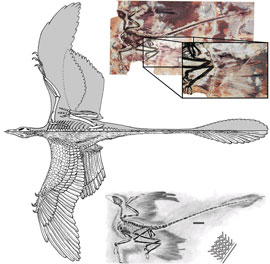 Early dinosaur flew like a biplane Early dinosaur flew like a biplane mongabay.com January 23, 2007 Reanalysis of fossil remains suggests that the earliest flying dinosaurs used two sets of wings like a biplane. Collage of images courtesy of Sankar Chatterjee. Reconstruction of flying dinosaur Microraptor gui (left); Holotype of flying dinosaur Microraptor gui, as […]
Early dinosaur flew like a biplane Early dinosaur flew like a biplane mongabay.com January 23, 2007 Reanalysis of fossil remains suggests that the earliest flying dinosaurs used two sets of wings like a biplane. Collage of images courtesy of Sankar Chatterjee. Reconstruction of flying dinosaur Microraptor gui (left); Holotype of flying dinosaur Microraptor gui, as […]
Leaf-mimicking insects at least 47 million years old
 Leaf-mimicking insects at least 47 million years old Leaf-mimicking insects at least 47 million years old mongabay.com December 25, 2006 With the discovery of a 47 million year old fossil of a lead insect, new research suggests that cryptic leaf-mimicking camoflauge is a time-tested strategy used by insects to avoid predators. Extant female (A) and […]
Leaf-mimicking insects at least 47 million years old Leaf-mimicking insects at least 47 million years old mongabay.com December 25, 2006 With the discovery of a 47 million year old fossil of a lead insect, new research suggests that cryptic leaf-mimicking camoflauge is a time-tested strategy used by insects to avoid predators. Extant female (A) and […]
Giant dinosaur discovered in Spain – largest ever recorded in Europe
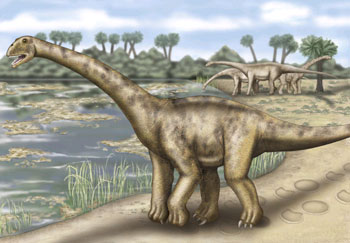 Giant dinosaur discovered in Spain, largest ever recorded in Europe Giant dinosaur discovered in Spain, largest ever recorded in Europe mongabay.com December 21, 2006 Researchers working in Teruel, Spain have discovered the fossil remains of a giant dinosaur that weighed between 40 to 48 tons and was 30-37 meters (100-120 feet) long — the length […]
Giant dinosaur discovered in Spain, largest ever recorded in Europe Giant dinosaur discovered in Spain, largest ever recorded in Europe mongabay.com December 21, 2006 Researchers working in Teruel, Spain have discovered the fossil remains of a giant dinosaur that weighed between 40 to 48 tons and was 30-37 meters (100-120 feet) long — the length […]
How did giant dinosaurs digest their food without molars?
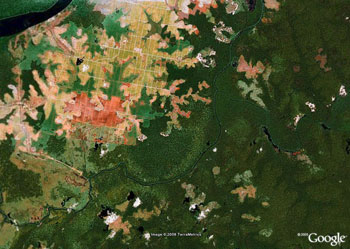 Borneo governor arrested in rainforest for palm oil fraud Borneo governor arrested in rainforest for palm oil fraud mongabay.com December 20, 2006 The governor of East Kalimantan on Indonesian part of the island of Borneo has been suspended and faces life in prison for his involvement in an oil palm plantation scheme that caused the […]
Borneo governor arrested in rainforest for palm oil fraud Borneo governor arrested in rainforest for palm oil fraud mongabay.com December 20, 2006 The governor of East Kalimantan on Indonesian part of the island of Borneo has been suspended and faces life in prison for his involvement in an oil palm plantation scheme that caused the […]
Mammals may have flown before birds
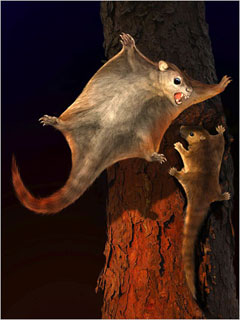 Mammals may have flown before birds, new fossil discovery suggests Mammals may have flown before birds mongabay.com December 13, 2006 Mammals may have flown before birds according to a fossil discovery by scientists working in China. Working in the Inner Mongolian region of China, a team of Chinese and American scientists discovered a 125 million […]
Mammals may have flown before birds, new fossil discovery suggests Mammals may have flown before birds mongabay.com December 13, 2006 Mammals may have flown before birds according to a fossil discovery by scientists working in China. Working in the Inner Mongolian region of China, a team of Chinese and American scientists discovered a 125 million […]
‘Loch Ness Monster’ found in Antarctica
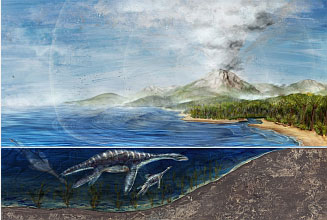 ‘Loch Ness Monster’ found in Antarctica ‘Loch Ness Monster’ found in Antarctica mongabay.com December 11, 2006 Paleontologists found a well-preserved fossil skeleton of a juvenile plesiosaur in Antarctica. Cryptozoologists say the plesiosaur resembles the legendary Loch Ness Monster, despite scientific evidence indicating that the marine reptile has been extinct for millions of years. According to […]
‘Loch Ness Monster’ found in Antarctica ‘Loch Ness Monster’ found in Antarctica mongabay.com December 11, 2006 Paleontologists found a well-preserved fossil skeleton of a juvenile plesiosaur in Antarctica. Cryptozoologists say the plesiosaur resembles the legendary Loch Ness Monster, despite scientific evidence indicating that the marine reptile has been extinct for millions of years. According to […]
Ancient hominid not our ancestor finds new study
Ancient hominid not our ancestor finds new study Ancient hominid not our ancestor finds new study mongabay.com December 7, 2006 Scientists have shown that ancient remains once thought to be a key link in man’s evolutionary history are 400,000 years to young to be part of human evolution. The results, published in the journal Science […]
Neanderthal life was miserable suggests new evidence
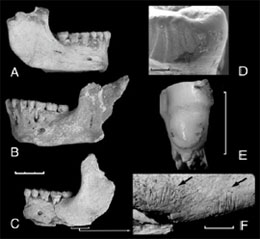 Neanderthal life was miserable suggests new evidence Neanderthal life was miserable suggests new evidence mongabay.com December 4, 2006 New analysis of 43,000-year-old samples of Neanderthal remains from Spain’s Iberian Peninsula suggest our relatives eked out a meager existence, possibly supplemented by cannibalism. The results are published in the early online edition of the Proceedings of […]
Neanderthal life was miserable suggests new evidence Neanderthal life was miserable suggests new evidence mongabay.com December 4, 2006 New analysis of 43,000-year-old samples of Neanderthal remains from Spain’s Iberian Peninsula suggest our relatives eked out a meager existence, possibly supplemented by cannibalism. The results are published in the early online edition of the Proceedings of […]
Ancient fish had bite like Tyrannosaurus rex
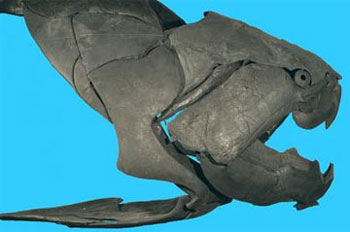 Ancient fish had bite like Tyrannosaurus rex Ancient fish had bite like Tyrannosaurus rex mongabay.com November 28, 2006 400-million years ago a 33-foot long, 4-ton fish terrorized the oceans with jaws that rivaled those of Tyrannosaurus rex, according to research published in the Royal Society journal Biology Letters on November 29. The predator, called Dunkleosteus […]
Ancient fish had bite like Tyrannosaurus rex Ancient fish had bite like Tyrannosaurus rex mongabay.com November 28, 2006 400-million years ago a 33-foot long, 4-ton fish terrorized the oceans with jaws that rivaled those of Tyrannosaurus rex, according to research published in the Royal Society journal Biology Letters on November 29. The predator, called Dunkleosteus […]
Ancient sea monster found in Montana
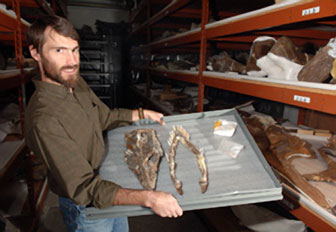 Ancient sea monster found in Montana Ancient sea monster found in Montana By Evelyn Boswell MSU News Service November 3, 2006 A fossil-hunting trip to celebrate a son’s homecoming resulted in the recent discovery of an ancient sea monster in central Montana. Believed to be approximately 70 million years old, its skull and lower jaw […]
Ancient sea monster found in Montana Ancient sea monster found in Montana By Evelyn Boswell MSU News Service November 3, 2006 A fossil-hunting trip to celebrate a son’s homecoming resulted in the recent discovery of an ancient sea monster in central Montana. Believed to be approximately 70 million years old, its skull and lower jaw […]
Researchers find the missing link for elephant evolution
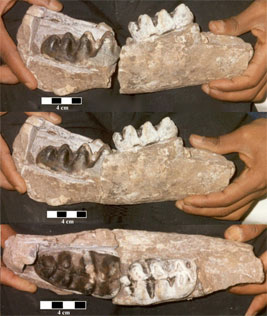 Researchers find the missing link for elephant evolution Researchers find the missing link for elephant evolution mongabay.com November 1, 2006 Scientists have discovered the missing link between ancient and modern elephants. The discovery of a 27 million-year old fossil belonging to a “pig-sized, tusked creature” suggests that “mastodons and the ancestors of elephants originated in […]
Researchers find the missing link for elephant evolution Researchers find the missing link for elephant evolution mongabay.com November 1, 2006 Scientists have discovered the missing link between ancient and modern elephants. The discovery of a 27 million-year old fossil belonging to a “pig-sized, tusked creature” suggests that “mastodons and the ancestors of elephants originated in […]
Ancient climate record preserved in prehistoric plants
Ancient climate record preserved in prehistoric plants Ancient climate record preserved in prehistoric plants Ancestor of modern trees preserves record of ancient climate change By Susan Trulove, Virginia Tech November 1, 2006 About 350 million years ago, at the boundary of the Devonian and Carboniferous ages, the climate changed. There was no one around to […]
Birds evolved from gliding four-legged dinosaurs
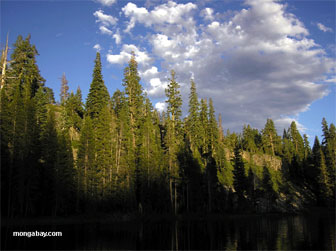 Birds evolved from gliding four-legged dinosaurs Birds evolved from gliding four-legged dinosaurs mongabay.com September 22, 2006 Birds may have evolved from gliding four-legged dinosaurs according to new research by a University of Calgary paleontologist. In a paper published in the journal Paleobiology, Department of Biological Sciences PhD student Nick Longrich argues that the earliest known […]
Birds evolved from gliding four-legged dinosaurs Birds evolved from gliding four-legged dinosaurs mongabay.com September 22, 2006 Birds may have evolved from gliding four-legged dinosaurs according to new research by a University of Calgary paleontologist. In a paper published in the journal Paleobiology, Department of Biological Sciences PhD student Nick Longrich argues that the earliest known […]
Recovery of biodiversity after dinosaurs was chaotic
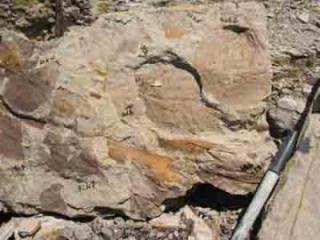 Recovery of biodiversity after dinosaurs was chaotic Recovery of biodiversity after dinosaurs was chaotic Recovery following mass extinction may be complex mongabay.com August 24, 2006 A new study suggests that the recovery of biodiversity following the extinction of dinosaurs may have been chaotic with broken ecological links leading to unbalanced plant-insect food webs. With present-day […]
Recovery of biodiversity after dinosaurs was chaotic Recovery of biodiversity after dinosaurs was chaotic Recovery following mass extinction may be complex mongabay.com August 24, 2006 A new study suggests that the recovery of biodiversity following the extinction of dinosaurs may have been chaotic with broken ecological links leading to unbalanced plant-insect food webs. With present-day […]
Ancient blue whale was a shark killer
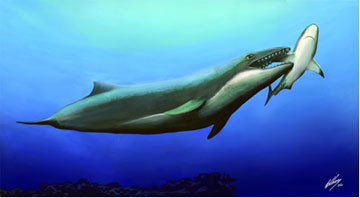 Ancient blue whale was a shark killer sharks, terrorized the seas Ancient blue whale was a shark killer Ancestor of baleen whales terrorized the seas mongabay.com August 21, 2006 A 25-million-year-old whale fossil from southeastern Australia suggests a curious origin for baleen whales. Presented at the at the Melbourne Museum last week, the fossil shows […]
Ancient blue whale was a shark killer sharks, terrorized the seas Ancient blue whale was a shark killer Ancestor of baleen whales terrorized the seas mongabay.com August 21, 2006 A 25-million-year-old whale fossil from southeastern Australia suggests a curious origin for baleen whales. Presented at the at the Melbourne Museum last week, the fossil shows […]
Ancient bison teeth provide window on past Great Plains climate
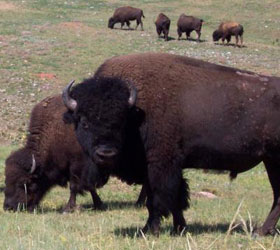 Ancient bison teeth provide window on past Great Plains climate Ancient bison teeth provide window on past Great Plains climate University of Washington August 7, 2006 A University of Washington researcher has devised a way to use the fossil teeth of ancient bison as a tool to reconstruct historic climate and vegetation changes in America’s […]
Ancient bison teeth provide window on past Great Plains climate Ancient bison teeth provide window on past Great Plains climate University of Washington August 7, 2006 A University of Washington researcher has devised a way to use the fossil teeth of ancient bison as a tool to reconstruct historic climate and vegetation changes in America’s […]
Giant “Turkeysaurus” dinosaur found in Utah
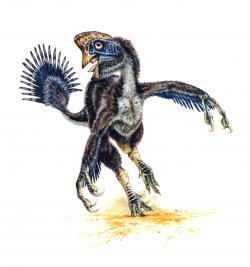 California plans to cut greenhouse gas emissions Giant “Turkeysaurus” dinosaur found in Utah Utah Museum of Natural History April 5, 2006 New “egg-thief” dinosaur roamed the southwest Scientists from the University of Utah and the Utah Museum of Natural History have discovered the remains of a new bird-like, meat-eating dinosaur in Grand Staircase-Escalante National Monument […]
California plans to cut greenhouse gas emissions Giant “Turkeysaurus” dinosaur found in Utah Utah Museum of Natural History April 5, 2006 New “egg-thief” dinosaur roamed the southwest Scientists from the University of Utah and the Utah Museum of Natural History have discovered the remains of a new bird-like, meat-eating dinosaur in Grand Staircase-Escalante National Monument […]
Picture of ancient missing link between fish and land animals
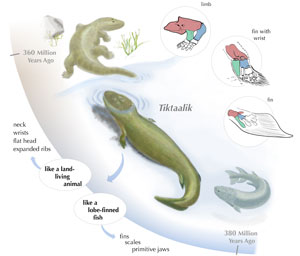 Pictures of missing link between fish and land animals Pictures of missing link between fish and land animals Ancient missing link between fish and land animals found University of Chicago April 5, 2006 Paleontologists have discovered fossils of a species that provides the missing evolutionary link between fish and the first animals that walked out […]
Pictures of missing link between fish and land animals Pictures of missing link between fish and land animals Ancient missing link between fish and land animals found University of Chicago April 5, 2006 Paleontologists have discovered fossils of a species that provides the missing evolutionary link between fish and the first animals that walked out […]
Pictures of newly discovered T-Rex dinosaur
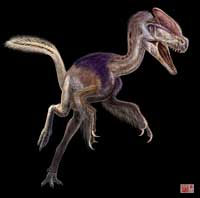 Pictures of newly discovered T-Rex dinosaur Pictures of newly discovered T-Rex dinosaur TEAM CO-LED BY GW PROFESSOR JAMES M. CLARK DISCOVERS SKELETONS OF THE OLDEST TYRANNOSAUR News release from George Washington University February 8, 2006 Newly discovered dinosaur was a mini version of Tyrannosaurus rex. Primitive Tyrannosaur with Crest on its Head Provides Significant New […]
Pictures of newly discovered T-Rex dinosaur Pictures of newly discovered T-Rex dinosaur TEAM CO-LED BY GW PROFESSOR JAMES M. CLARK DISCOVERS SKELETONS OF THE OLDEST TYRANNOSAUR News release from George Washington University February 8, 2006 Newly discovered dinosaur was a mini version of Tyrannosaurus rex. Primitive Tyrannosaur with Crest on its Head Provides Significant New […]
Chimps split from humans 5-7 million years ago says new study
 Chimps split from humans 5-7 million years ago says new study Chimps split from humans 5-7 million years ago says new study Rhett A. Butler, mongabay.com December 22, 2005 EDITOR’S SUMMARY: Chimpanzees diverged from humans only 5-7 million years ago according to a newly released study of gene sequences. The research significantly narrows the time […]
Chimps split from humans 5-7 million years ago says new study Chimps split from humans 5-7 million years ago says new study Rhett A. Butler, mongabay.com December 22, 2005 EDITOR’S SUMMARY: Chimpanzees diverged from humans only 5-7 million years ago according to a newly released study of gene sequences. The research significantly narrows the time […]
500,000-year-old chimpanzee fossil found
500,000-year-old chimpanzee fossil found 500,000-year-old chimpanzee fossil found Rhett A. Butler, mongabay.com September 6, 2005 Palaeontologists discovered the first known chimpanzee fossil while digging near Lake Baringo, Kenya. The find is described in this week’s edition of Nature [1] although a summary of the article is available online. The fossil teeth are estimated to be […]
Feeds: news | india | latam | brasil | indonesia
 In a cave in Australia, researchers from the University of New South Wales discovered giant fossilized sperm. The sperm were produced 17 million years ago by a group of tiny, shelled crustaceans called ostracods, making them the oldest fossilized sperm ever found. The results were published recently in Proceedings of the Royal Society B. The […]
In a cave in Australia, researchers from the University of New South Wales discovered giant fossilized sperm. The sperm were produced 17 million years ago by a group of tiny, shelled crustaceans called ostracods, making them the oldest fossilized sperm ever found. The results were published recently in Proceedings of the Royal Society B. The […] Scientific American magazine recently ran an article on the rediscovery of the smoothtooth blacktip shark (Carcharhinus leiodon) in a Kuwaiti fish market. Believed extinct for over 100 years, the smoothtooth had not been seen since the naturalist Wilhelm Hein returned from a trip to Yemen in 1902. With its reappearance, scientists scoured Kuwaiti markets and […]
Scientific American magazine recently ran an article on the rediscovery of the smoothtooth blacktip shark (Carcharhinus leiodon) in a Kuwaiti fish market. Believed extinct for over 100 years, the smoothtooth had not been seen since the naturalist Wilhelm Hein returned from a trip to Yemen in 1902. With its reappearance, scientists scoured Kuwaiti markets and […] Based on a single tooth from Australia, scientists believe they have discovered a giant, meter-long (3.3 feet) duck-billed platypus that likely fed on fish, frogs, and even turtles, according to a new study in Journal of Vertebrate Paleontology. At least twice the size of a modern duckbilled platypus, the scientists say the extinct giant likely […]
Based on a single tooth from Australia, scientists believe they have discovered a giant, meter-long (3.3 feet) duck-billed platypus that likely fed on fish, frogs, and even turtles, according to a new study in Journal of Vertebrate Paleontology. At least twice the size of a modern duckbilled platypus, the scientists say the extinct giant likely […] Rainforests in South America have endured three previous extreme global warming events in the past, suggesting they will survive a projected 2-6 degree rise in temperatures over the coming century, reports a study published in the Annual Review of Earth and Planetary Science. The research, published by Carlos Jaramillo and Andrés Cárdenas of the Smithsonian […]
Rainforests in South America have endured three previous extreme global warming events in the past, suggesting they will survive a projected 2-6 degree rise in temperatures over the coming century, reports a study published in the Annual Review of Earth and Planetary Science. The research, published by Carlos Jaramillo and Andrés Cárdenas of the Smithsonian […] Half a billion years after an arthropod with long triple claws roamed the shallow Cambrian seas, scientists have named it after Hollywood movie actor, Johnny Depp: Kooteninchela deppi. Depp, known for his versatility as an actor, played Edward Scissorhands—an artificial man with long scissors for hands—in a popular 1990 film. “When I first saw the […]
Half a billion years after an arthropod with long triple claws roamed the shallow Cambrian seas, scientists have named it after Hollywood movie actor, Johnny Depp: Kooteninchela deppi. Depp, known for his versatility as an actor, played Edward Scissorhands—an artificial man with long scissors for hands—in a popular 1990 film. “When I first saw the […] The bleached bones of seabirds are telling us a new story about the far-reaching impacts of industrial fisheries on today’s oceans. Looking at the isotopes of 250 bones from Hawaiian petrels (Pterodroma sandwichensis), scientists have been able to reconstruct the birds’ diets over the last 3,000 years. They found an unmistakable shift from big prey […]
The bleached bones of seabirds are telling us a new story about the far-reaching impacts of industrial fisheries on today’s oceans. Looking at the isotopes of 250 bones from Hawaiian petrels (Pterodroma sandwichensis), scientists have been able to reconstruct the birds’ diets over the last 3,000 years. They found an unmistakable shift from big prey […] One of the survivors: the Takahē, a flightless rail from New Zealand. Photo by: © ZSL. Around 4,000 years ago intrepid Polynesian seafarers made their way into an untamed wilderness: the far-flung Pacific Islands. Over a thousands or so years, they rowed from one island to another, stepping on shores never yet seen by humans. […]
One of the survivors: the Takahē, a flightless rail from New Zealand. Photo by: © ZSL. Around 4,000 years ago intrepid Polynesian seafarers made their way into an untamed wilderness: the far-flung Pacific Islands. Over a thousands or so years, they rowed from one island to another, stepping on shores never yet seen by humans. […] Reconstruction of Carbonemys preying upon a small crocodylomorph. Courtesy of Cadena et al. 2012 Researchers working in Colombia has discovered the fossilized remains of a giant freshwater turtle that lived some 60 million years ago. The turtle, named Carbonemys cofrinii or the “coal turtle”, had a shell measuring 5 feet 7 inches and an overall […]
Reconstruction of Carbonemys preying upon a small crocodylomorph. Courtesy of Cadena et al. 2012 Researchers working in Colombia has discovered the fossilized remains of a giant freshwater turtle that lived some 60 million years ago. The turtle, named Carbonemys cofrinii or the “coal turtle”, had a shell measuring 5 feet 7 inches and an overall […] An extinct marsupial mega-herbivore, Diprotodon optatum. Drawing by Peter Murray. Image © Science/AAAS. The theory that humans, and not climate change, was primarily responsible for the extinction of giant marsupials in prehistoric Australia takes another step forward with a new study in Science. Exploring sediment cores for past evidence of big herbivores, researchers found that […]
An extinct marsupial mega-herbivore, Diprotodon optatum. Drawing by Peter Murray. Image © Science/AAAS. The theory that humans, and not climate change, was primarily responsible for the extinction of giant marsupials in prehistoric Australia takes another step forward with a new study in Science. Exploring sediment cores for past evidence of big herbivores, researchers found that […] An artist’s recreation of Microraptor, a pigeon-sized, four-winged dinosaur that lived about 130 million years ago. Recent research has shown that the dinosaur had iridescent plumage. Image by: Jason Brougham/University of Texas. The more we discover about dinosaurs, the more these “terrible lizards” resemble otherworldly birds. None more so than the microraptor, which paleontologists have […]
An artist’s recreation of Microraptor, a pigeon-sized, four-winged dinosaur that lived about 130 million years ago. Recent research has shown that the dinosaur had iridescent plumage. Image by: Jason Brougham/University of Texas. The more we discover about dinosaurs, the more these “terrible lizards” resemble otherworldly birds. None more so than the microraptor, which paleontologists have […] Ocean acidification growing at a rate faster than anytime in 300 million years. To the left a discoaster of marine plankton before an ocean acidification event 56 million years ago, and to the right its counterpart corroded by ocean acidification event. Image taken with a scanning electron microscope (SEM). Human emissions of carbon dioxide may […]
Ocean acidification growing at a rate faster than anytime in 300 million years. To the left a discoaster of marine plankton before an ocean acidification event 56 million years ago, and to the right its counterpart corroded by ocean acidification event. Image taken with a scanning electron microscope (SEM). Human emissions of carbon dioxide may […] Coyote feeding on elk carcass in Yellowstone National Park. Photo by: Jim Peaco/U.S. National Park Service. Not long ago, geologically speaking, coyotes (Canis latrans) were bigger and more robust than today’s animals. In the late Pleistocene, over 10,000 years ago, coyotes rivaled grey wolves (Canis lupus) in size. But, according to a new paper in […]
Coyote feeding on elk carcass in Yellowstone National Park. Photo by: Jim Peaco/U.S. National Park Service. Not long ago, geologically speaking, coyotes (Canis latrans) were bigger and more robust than today’s animals. In the late Pleistocene, over 10,000 years ago, coyotes rivaled grey wolves (Canis lupus) in size. But, according to a new paper in […] Two Kairuku penguins come ashore, passing a stranded Waipatia dolphin. Artwork by Chris Gaskin, owner and copyright owner: Geology Museum, University of Otago.. Around 25 million years ago a penguin with a long, sharp beak and massive flippers lived in a New Zealand that was almost entirely underwater. The bird, named Kairuku after a Maori […]
Two Kairuku penguins come ashore, passing a stranded Waipatia dolphin. Artwork by Chris Gaskin, owner and copyright owner: Geology Museum, University of Otago.. Around 25 million years ago a penguin with a long, sharp beak and massive flippers lived in a New Zealand that was almost entirely underwater. The bird, named Kairuku after a Maori […] Innovative research has made a long-extinct katydid—which inhabited the world of dinosaurs like stegosaurus, allosaurus, and diplodocus—sing again. The discovery of an incredibly well-preserved fossil of a new species of katydid, dubbed Archaboilus musicus, gave biomechanical experts the opportunity to recreate a song not heard in 165 million years, according to new research published in […]
Innovative research has made a long-extinct katydid—which inhabited the world of dinosaurs like stegosaurus, allosaurus, and diplodocus—sing again. The discovery of an incredibly well-preserved fossil of a new species of katydid, dubbed Archaboilus musicus, gave biomechanical experts the opportunity to recreate a song not heard in 165 million years, according to new research published in […] Associated Press melaporkan bahawa saintis telah menemui dua spesis dinosaur di Utah yang sehingga kini belum diketahui spesisnya. Spesis tersebut telah dihuraikan dalam jurnal terbaru PLoS ONE. Kedua-dua spesis tersebut adalah berkaitan dengan Triceratops. Salah satu ialah Kosmocratops richardsoni, mempunyai 15 tanduk di atas kepalanya. Manakala selebihnya ialah Utahceratops, yang hanya mempunyai lima tanduk. Kosmoceratops […]
Associated Press melaporkan bahawa saintis telah menemui dua spesis dinosaur di Utah yang sehingga kini belum diketahui spesisnya. Spesis tersebut telah dihuraikan dalam jurnal terbaru PLoS ONE. Kedua-dua spesis tersebut adalah berkaitan dengan Triceratops. Salah satu ialah Kosmocratops richardsoni, mempunyai 15 tanduk di atas kepalanya. Manakala selebihnya ialah Utahceratops, yang hanya mempunyai lima tanduk. Kosmoceratops […] Associated Press melaporkan bahawa saintis telah menemui dua spesis dinosaur di Utah yang sehingga kini belum diketahui spesisnya. Spesis tersebut telah dihuraikan dalam jurnal terbaru PLoS ONE. Kedua-dua spesis tersebut adalah berkaitan dengan Triceratops. Salah satu ialah Kosmoceratops richardsoni, mempunyai 15 tanduk di atas kepalanya. Manakala selebihnya ialah Utahceratops gettyi, yang hanya mempunyai lima tanduk. […]
Associated Press melaporkan bahawa saintis telah menemui dua spesis dinosaur di Utah yang sehingga kini belum diketahui spesisnya. Spesis tersebut telah dihuraikan dalam jurnal terbaru PLoS ONE. Kedua-dua spesis tersebut adalah berkaitan dengan Triceratops. Salah satu ialah Kosmoceratops richardsoni, mempunyai 15 tanduk di atas kepalanya. Manakala selebihnya ialah Utahceratops gettyi, yang hanya mempunyai lima tanduk. […] Famed paleoanthropologist Richard Leakey envisions the future with a view that remembers the past Looking Back: A family world famous for discovery. Richard Leakey and his parents, Louis and Mary Leakey. Time Magazine cover, featuring Dr Richard Leakey, courtesy of Time Warner. Leakey family photos courtesy of Academy of Achievement.org. Following in his family’s footsteps, […]
Famed paleoanthropologist Richard Leakey envisions the future with a view that remembers the past Looking Back: A family world famous for discovery. Richard Leakey and his parents, Louis and Mary Leakey. Time Magazine cover, featuring Dr Richard Leakey, courtesy of Time Warner. Leakey family photos courtesy of Academy of Achievement.org. Following in his family’s footsteps, […] Modern-day Nile crocodile Researchers excavating a coal mine in Colombia have discovered a previously unknown species of prehistoric crocodile. The beast is described in the September 15 issue of the journal Palaeontology. The freswhwater crocodile, named Acherontisuchus guajiraensis, lived some 60 million years ago in swampy habitats shared with Titanoboa, the world’s largest known snake. […]
Modern-day Nile crocodile Researchers excavating a coal mine in Colombia have discovered a previously unknown species of prehistoric crocodile. The beast is described in the September 15 issue of the journal Palaeontology. The freswhwater crocodile, named Acherontisuchus guajiraensis, lived some 60 million years ago in swampy habitats shared with Titanoboa, the world’s largest known snake. […] Scientists have announced the discovery of a new species of carnivorous dinosaur which lived 230 million years ago in what is today Argentina. Eodromaeus, which means “dawn runner”, weighed only 10-15 pounds and reached a length of 1.3 meters (4 feet), but it packed a punch with saber-shaped upper teeth for grabbing prey. Scientists believe […]
Scientists have announced the discovery of a new species of carnivorous dinosaur which lived 230 million years ago in what is today Argentina. Eodromaeus, which means “dawn runner”, weighed only 10-15 pounds and reached a length of 1.3 meters (4 feet), but it packed a punch with saber-shaped upper teeth for grabbing prey. Scientists believe […] Scientists have discovered an extinct massive stork, standing nearly 6 feet tall (1.8 meter) and weighing 35 pounds (15 kilograms), which would have shared the island of Flores with the ‘hobbits’—dwarf hominin species known as Homo floresiensis—reports the BBC. According to the researchers the meat-eating stork was big enough to prey on young Homo floresiensis, […]
Scientists have discovered an extinct massive stork, standing nearly 6 feet tall (1.8 meter) and weighing 35 pounds (15 kilograms), which would have shared the island of Flores with the ‘hobbits’—dwarf hominin species known as Homo floresiensis—reports the BBC. According to the researchers the meat-eating stork was big enough to prey on young Homo floresiensis, […] Paleontologists have unearthed fossil remains of a giant species of penguin that roamed the Earth 36 million years ago, according to research published in Science. Excavating a site in Peru, Julia Clarke, of The University of Texas and colleagues, found the first extinct penguin with preserved evidence of scales and feathers. The new species Inkayacu […]
Paleontologists have unearthed fossil remains of a giant species of penguin that roamed the Earth 36 million years ago, according to research published in Science. Excavating a site in Peru, Julia Clarke, of The University of Texas and colleagues, found the first extinct penguin with preserved evidence of scales and feathers. The new species Inkayacu […] Scientists discovered two previously unknown species of dinosaur in southern Utah, reports the Associated Press. The species are described in the current issue of the journal PLoS ONE. Both species are closely related to the Triceratops. One, Kosmoceratops richardsoni, had 15 horns on its head, while the other, Utahceratops gettyi, had five. Kosmoceratops richardsoni was […]
Scientists discovered two previously unknown species of dinosaur in southern Utah, reports the Associated Press. The species are described in the current issue of the journal PLoS ONE. Both species are closely related to the Triceratops. One, Kosmoceratops richardsoni, had 15 horns on its head, while the other, Utahceratops gettyi, had five. Kosmoceratops richardsoni was […] A dinosaur mystery over a hundred years old has been unraveled according to a new study in the Proceedings of the National Academy of Sciences. In 1895 a woman discovered dinosaur bones on her family estate in Transylvania, a region in present-day Romania. Fortunately, her brother was paleontologist Franz Baron Nopsca; he declared that the […]
A dinosaur mystery over a hundred years old has been unraveled according to a new study in the Proceedings of the National Academy of Sciences. In 1895 a woman discovered dinosaur bones on her family estate in Transylvania, a region in present-day Romania. Fortunately, her brother was paleontologist Franz Baron Nopsca; he declared that the […] Sauropod babies for breakfast A fossilized snake has been discovered inside a titanosaur nest in India, leading researchers to conclude that the snake fed on newly-hatched dinosaur babies, rather than their eggs like modern snakes. Paleontologist and snake expert Jason Head says that the snake, known as Sanajeh indicus, lacked the wipe-jaws needed to swallow […]
Sauropod babies for breakfast A fossilized snake has been discovered inside a titanosaur nest in India, leading researchers to conclude that the snake fed on newly-hatched dinosaur babies, rather than their eggs like modern snakes. Paleontologist and snake expert Jason Head says that the snake, known as Sanajeh indicus, lacked the wipe-jaws needed to swallow […] One of the most well-known animals, the polar bear, is a newcomer on the world stage, according to research published in the Proceedings of the National Academy of Sciences. By studying the DNA of an ancient polar bear jawbone uncovered in 2004 in Norway scientists have for the first time pinpointed the time when the […]
One of the most well-known animals, the polar bear, is a newcomer on the world stage, according to research published in the Proceedings of the National Academy of Sciences. By studying the DNA of an ancient polar bear jawbone uncovered in 2004 in Norway scientists have for the first time pinpointed the time when the […] It sounds like something out of Greek mythology: a half-goat, half-reptilian creature. But researchers have discovered that an extinct species of goat, the Balearic Island cave goat or Myotragus balearicus, survived in nutrient-poor Mediterranean islands by evolving reptilian-specific characteristics. The goat, much like crocodiles, was able to grow at flexible rates, stopping growth entirely when […]
It sounds like something out of Greek mythology: a half-goat, half-reptilian creature. But researchers have discovered that an extinct species of goat, the Balearic Island cave goat or Myotragus balearicus, survived in nutrient-poor Mediterranean islands by evolving reptilian-specific characteristics. The goat, much like crocodiles, was able to grow at flexible rates, stopping growth entirely when […] Arctic researcher: ‘we have entered unchartered territory’ The Arctic should be growing cooler, but a new sediment core taken from an Arctic lake reveals that the lake’s ecology and chemistry has been transformed by unnatural warming beginning in the 1950s. The sediment core proves that changes happening in the lake during the Twentieth Century are […]
Arctic researcher: ‘we have entered unchartered territory’ The Arctic should be growing cooler, but a new sediment core taken from an Arctic lake reveals that the lake’s ecology and chemistry has been transformed by unnatural warming beginning in the 1950s. The sediment core proves that changes happening in the lake during the Twentieth Century are […] The long-held assumption that Madagascar has lost 90 percent of its forest cover due to fire and slash-and-burn agriculture may be overstated, argues new research published in Conservation Letters. Analyzing 6000-year pollen records in four sites, Malika Virah-Sawmy of Oxford University found evidence that vegetation in southeast Madagascar has for millennia been a mosaic of […]
The long-held assumption that Madagascar has lost 90 percent of its forest cover due to fire and slash-and-burn agriculture may be overstated, argues new research published in Conservation Letters. Analyzing 6000-year pollen records in four sites, Malika Virah-Sawmy of Oxford University found evidence that vegetation in southeast Madagascar has for millennia been a mosaic of […] Extinction can be set in motion millions of years before a species’ actual demise, suggesting that present-day drivers of habitat destruction and degradation may have already doomed many species to eventual extinction, report researchers writing in Proceedings of the Royal Society B online. Analyzing the fossil record of microscopic coral-like animals known as cupuladriid bryozoans, […]
Extinction can be set in motion millions of years before a species’ actual demise, suggesting that present-day drivers of habitat destruction and degradation may have already doomed many species to eventual extinction, report researchers writing in Proceedings of the Royal Society B online. Analyzing the fossil record of microscopic coral-like animals known as cupuladriid bryozoans, […] A new study, published in the journal Geology, estimates the age of the Amazon river at 11 million years. Conducting analysis of sedimentological and paleontological data obtained by drilling deep boreholes (up to 4.5 kilometers or 2.8 miles deep) near the mouth of the Amazon, a team of scientists from University of Amsterdam, the University […]
A new study, published in the journal Geology, estimates the age of the Amazon river at 11 million years. Conducting analysis of sedimentological and paleontological data obtained by drilling deep boreholes (up to 4.5 kilometers or 2.8 miles deep) near the mouth of the Amazon, a team of scientists from University of Amsterdam, the University […]


 Missing link between fish and land animals discovered Missing link between fish and land animals discovered By Morgan Erickson-Davis, special to mongabay.com November 7, 2008 New fossil brings more insight into vertebrates’ transition to life on land
Missing link between fish and land animals discovered Missing link between fish and land animals discovered By Morgan Erickson-Davis, special to mongabay.com November 7, 2008 New fossil brings more insight into vertebrates’ transition to life on land Past climate change drove mass extinction in Pakistan Past climate change drove mass extinction in Pakistan Jeremy Hance, mongabay.com September 26, 2008 Past climate change cut mammal biodiversity by over half in lost ecosystem Research on long-vanished mammals in the Siwalik region of Northern Pakistan has yielded results relevant for today. In the span of […]
Past climate change drove mass extinction in Pakistan Past climate change drove mass extinction in Pakistan Jeremy Hance, mongabay.com September 26, 2008 Past climate change cut mammal biodiversity by over half in lost ecosystem Research on long-vanished mammals in the Siwalik region of Northern Pakistan has yielded results relevant for today. In the span of […] Researchers devise new comparison of mass extinction events Researchers devise new comparison of mass extinction events mongabay.com September 2, 2008 Researchers have created a new way to compare historical mass extinction events. The scoring system, presented in the early online edition of the journal Proceedings of the National Academy of Sciences, works by multiplying the […]
Researchers devise new comparison of mass extinction events Researchers devise new comparison of mass extinction events mongabay.com September 2, 2008 Researchers have created a new way to compare historical mass extinction events. The scoring system, presented in the early online edition of the journal Proceedings of the National Academy of Sciences, works by multiplying the […] Humans – not climate – drove extinction of giant Tasmanian animals Humans – not climate – drove extinction of giant Tasmanian animals mongabay.com August 11, 2008 Humans — not climate change — were responsible for the mass extinction of Australia’s megafauna, according to a new study published this week in the journal Proceedings of the […]
Humans – not climate – drove extinction of giant Tasmanian animals Humans – not climate – drove extinction of giant Tasmanian animals mongabay.com August 11, 2008 Humans — not climate change — were responsible for the mass extinction of Australia’s megafauna, according to a new study published this week in the journal Proceedings of the […] Humans and global warming responsible for extinction of mammoths Humans and global warming responsible for extinction of mammoths mongabay.com March 31, 2008 Study confirms that habitat fragmentation, caused by climate change, split species into small populations, making them more vulnerable to extinction. The combination of human hunting pressure and climate change was responsible for the […]
Humans and global warming responsible for extinction of mammoths Humans and global warming responsible for extinction of mammoths mongabay.com March 31, 2008 Study confirms that habitat fragmentation, caused by climate change, split species into small populations, making them more vulnerable to extinction. The combination of human hunting pressure and climate change was responsible for the […] 10-pound ‘Giant Frog From Hell’ ate baby dinosaurs 10-pound ‘Giant Frog From Hell’ discovered in Madagascar mongabay.com February 18, 2008 Researchers have discovered the remains of what may be the largest frog ever to exist. Working in Madagascar, scientists led by Stony Brook University paleontologist Dr. David Krause found the remains of a 16-inch, 10-pound […]
10-pound ‘Giant Frog From Hell’ ate baby dinosaurs 10-pound ‘Giant Frog From Hell’ discovered in Madagascar mongabay.com February 18, 2008 Researchers have discovered the remains of what may be the largest frog ever to exist. Working in Madagascar, scientists led by Stony Brook University paleontologist Dr. David Krause found the remains of a 16-inch, 10-pound […] New duck-billed dinosaur discovered in Mexico New duck-billed dinosaur discovered in Mexico mongabay.com February 12, 2008 A previously unknown species of dinosaur has been discovered in Mexico, shadding new light on the history of western North America, report researchers from the Utah Museum of Natural History at the University of Utah. The 72-million-year-old ago beast, […]
New duck-billed dinosaur discovered in Mexico New duck-billed dinosaur discovered in Mexico mongabay.com February 12, 2008 A previously unknown species of dinosaur has been discovered in Mexico, shadding new light on the history of western North America, report researchers from the Utah Museum of Natural History at the University of Utah. The 72-million-year-old ago beast, […] Two strange carnivorous dinosaurs discovered in the Sahara Two strange carnivorous dinosaurs discovered in the Sahara mongabay.com February 13, 2008 Two previously unknown species of dinosaur discovered in the Sahara were unusual meat-eaters, report scientists from the University of Chicago and the University of Bristol. Short-snouted Kryptops palaios, or “old hidden face,” was named for […]
Two strange carnivorous dinosaurs discovered in the Sahara Two strange carnivorous dinosaurs discovered in the Sahara mongabay.com February 13, 2008 Two previously unknown species of dinosaur discovered in the Sahara were unusual meat-eaters, report scientists from the University of Chicago and the University of Bristol. Short-snouted Kryptops palaios, or “old hidden face,” was named for […] Mini-pterodactyl discovered in China Mini-pterodactyl discovered in China mongabay.com February 11, 2008 Scientists have discovered a previously unknown species of pterodactyl in northeastern China. Life reconstructions of Nemicolopterus crypticus, a small derived flying reptile that lived in the gingko forests that existed some 120 million years ago in present China. Top image courtesy of Chuang […]
Mini-pterodactyl discovered in China Mini-pterodactyl discovered in China mongabay.com February 11, 2008 Scientists have discovered a previously unknown species of pterodactyl in northeastern China. Life reconstructions of Nemicolopterus crypticus, a small derived flying reptile that lived in the gingko forests that existed some 120 million years ago in present China. Top image courtesy of Chuang […] Global warming to increase insect attacks on plants Global warming to increase insect attacks on plants mongabay.com February 11, 2008 Global warming will increase attacks on plant leaves by insects, reports a study published in Proceedings of the National Academy of Sciences. Analyzing more than 5,000 fossilized leaves dating from the Paleocene-Eocene Thermal Maximum (PETM), […]
Global warming to increase insect attacks on plants Global warming to increase insect attacks on plants mongabay.com February 11, 2008 Global warming will increase attacks on plant leaves by insects, reports a study published in Proceedings of the National Academy of Sciences. Analyzing more than 5,000 fossilized leaves dating from the Paleocene-Eocene Thermal Maximum (PETM), […] Recovery from worst mass extinction took 30 million years Recovery from worst mass extinction took 30 million years mongabay.com January 20, 2008 The recovery of complex ecosystems following history’s worst mass extinction took 30 million years reports a study published last week in Proceedings of the Royal Society B. Analyzing the recovery of tetrapods — […]
Recovery from worst mass extinction took 30 million years Recovery from worst mass extinction took 30 million years mongabay.com January 20, 2008 The recovery of complex ecosystems following history’s worst mass extinction took 30 million years reports a study published last week in Proceedings of the Royal Society B. Analyzing the recovery of tetrapods — […] 2,000 pound rodent discovered 2,000 pound rodent discovered mongabay.com January 16, 2008 Scientists have discovered the remains of an extinct 2,000 pound rodent — the largest rodent ever known. The find is described Wednesday in Britain’s Proceedings of the Royal Society. “We report the discovery of an exceptionally well preserved fossil skull of a new […]
2,000 pound rodent discovered 2,000 pound rodent discovered mongabay.com January 16, 2008 Scientists have discovered the remains of an extinct 2,000 pound rodent — the largest rodent ever known. The find is described Wednesday in Britain’s Proceedings of the Royal Society. “We report the discovery of an exceptionally well preserved fossil skull of a new […] Despite crocs in the Arctic, glaciers existed during extreme warming 90M years ago Despite Arctic crocodiles, glaciers existed during extreme global warming 90M years ago mongabay.com January 10, 2008 Massive glaciers extended across 50-60 percent of Antarctica some 91.2 million years even as crocodiles roamed the Arctic and surface temperatures of the western tropical Atlantic […]
Despite crocs in the Arctic, glaciers existed during extreme warming 90M years ago Despite Arctic crocodiles, glaciers existed during extreme global warming 90M years ago mongabay.com January 10, 2008 Massive glaciers extended across 50-60 percent of Antarctica some 91.2 million years even as crocodiles roamed the Arctic and surface temperatures of the western tropical Atlantic […] Evolution of whales challenged Origin of whales challenged mongabay.com December 19, 2007 Modern whales appear to have evolved from a raccoon-sized creature with the body of a small deer, according to scientists writing in the journal Nature. The results challenge the theory that cetaceans are descended from even-toed ungulates (artiodactyls) like hippos, as previous molecular […]
Evolution of whales challenged Origin of whales challenged mongabay.com December 19, 2007 Modern whales appear to have evolved from a raccoon-sized creature with the body of a small deer, according to scientists writing in the journal Nature. The results challenge the theory that cetaceans are descended from even-toed ungulates (artiodactyls) like hippos, as previous molecular […] Massive carnivorous dinosaur discovered Massive carnivorous dinosaur discovered mongabay.com December 11, 2007 A massive carnivorous dinosaur discovered in Niger has been described as a new species, according to research published in current issue of the Journal of Vertebrate Paleontology. Carcharodontosaurus iguidensis, as the species is known, is one of the largest carnivorous dinosaurs ever found, […]
Massive carnivorous dinosaur discovered Massive carnivorous dinosaur discovered mongabay.com December 11, 2007 A massive carnivorous dinosaur discovered in Niger has been described as a new species, according to research published in current issue of the Journal of Vertebrate Paleontology. Carcharodontosaurus iguidensis, as the species is known, is one of the largest carnivorous dinosaurs ever found, […] Global warming may provoke evolution Global warming may provoke evolution mongabay.com November 26, 2007 Some 80 million years ago, during a period of global warming, a group of relatively immobile salamanders trekked from western North America to the continent that became Asia, report researchers writing in this week’s issue of the journal Proceedings of the […]
Global warming may provoke evolution Global warming may provoke evolution mongabay.com November 26, 2007 Some 80 million years ago, during a period of global warming, a group of relatively immobile salamanders trekked from western North America to the continent that became Asia, report researchers writing in this week’s issue of the journal Proceedings of the […] Cow-like dinosaur discovered Cow-like dinosaur discovered mongabay.com November 15, 2007 A dinosaur discovered in the Sahara had a mouth that worked like a vacuum cleaner and operated more like a “Mesozoic cow” than a reptile, report researchers writing in today’s issue of the journal PLoS ONE. Conducting CT scans on Nigersaurus taqueti–as the beast is […]
Cow-like dinosaur discovered Cow-like dinosaur discovered mongabay.com November 15, 2007 A dinosaur discovered in the Sahara had a mouth that worked like a vacuum cleaner and operated more like a “Mesozoic cow” than a reptile, report researchers writing in today’s issue of the journal PLoS ONE. Conducting CT scans on Nigersaurus taqueti–as the beast is […] Missing link between humans and apes possibly discovered Missing link between humans and apes possibly discovered mongabay.com November 12, 2007 A 10 million-year-old jawbone discovered in Kenya may represent a new species very close to the last common ancestor of gorillas, chimpanzees, and humans, report researchers writing in the current issue of the journal Proceedings […]
Missing link between humans and apes possibly discovered Missing link between humans and apes possibly discovered mongabay.com November 12, 2007 A 10 million-year-old jawbone discovered in Kenya may represent a new species very close to the last common ancestor of gorillas, chimpanzees, and humans, report researchers writing in the current issue of the journal Proceedings […] Climate change did not cause extinction of Neanderthals Climate change did not cause extinction of Neanderthals mongabay.com September 12, 2007 Researchers in Europe have found evidence that rules out a “single climatic event” as a factor in the extinction of Neanderthals. Mapping radiocarbon dates of Neanderthal bones from Gorham’s Cave in Gibraltar directly onto a […]
Climate change did not cause extinction of Neanderthals Climate change did not cause extinction of Neanderthals mongabay.com September 12, 2007 Researchers in Europe have found evidence that rules out a “single climatic event” as a factor in the extinction of Neanderthals. Mapping radiocarbon dates of Neanderthal bones from Gorham’s Cave in Gibraltar directly onto a […] Climate change drove human evolution Climate change drove human evolution mongabay.com September 3, 2007 Climate change appears to have been a significant driver of human evolution, report researchers writing in this week’s issue of the journal Proceedings of the National Academy of Science (PNAS). Studying deep sediment cores from Lake Malawi in Africa, Syracuse University […]
Climate change drove human evolution Climate change drove human evolution mongabay.com September 3, 2007 Climate change appears to have been a significant driver of human evolution, report researchers writing in this week’s issue of the journal Proceedings of the National Academy of Science (PNAS). Studying deep sediment cores from Lake Malawi in Africa, Syracuse University […] Oldest orchid discovered; suggests flower co-existed with dinosaurs Orchids may have co-existed with dinosaurs mongabay.com August 29, 2007 Orchids are old enough to have co-existed with dinosaurs, report Harvard University scientists. Writing in the journal Nature, the researchers found the earliest evidence of pollination on the fossil record by examining the remains of an ancient […]
Oldest orchid discovered; suggests flower co-existed with dinosaurs Orchids may have co-existed with dinosaurs mongabay.com August 29, 2007 Orchids are old enough to have co-existed with dinosaurs, report Harvard University scientists. Writing in the journal Nature, the researchers found the earliest evidence of pollination on the fossil record by examining the remains of an ancient […] T. rex could outrun a human athlete T. rex could outrun a human athlete mongabay.com August 22, 2007 T. rex could reach speeds of up to 18mph, according to new supercomputer simulations that are believed to be the most accurate projections ever produced. However T. rex could be easily outrun by the smaller Compsognathus, which […]
T. rex could outrun a human athlete T. rex could outrun a human athlete mongabay.com August 22, 2007 T. rex could reach speeds of up to 18mph, according to new supercomputer simulations that are believed to be the most accurate projections ever produced. However T. rex could be easily outrun by the smaller Compsognathus, which […] Dinosaurs’ rise to dominance was a gradual Dinosaurs’ rise to dominance was a gradual mongabay.com July 19, 2007 Dinosaurs’ rise to dominance was a gradual rather than sudden, suggests new research published in Science. This scene depicts four dinosaurs and dinosaur precursors from the Hayden Quarry of northern New Mexico. The coexistence during the Late […]
Dinosaurs’ rise to dominance was a gradual Dinosaurs’ rise to dominance was a gradual mongabay.com July 19, 2007 Dinosaurs’ rise to dominance was a gradual rather than sudden, suggests new research published in Science. This scene depicts four dinosaurs and dinosaur precursors from the Hayden Quarry of northern New Mexico. The coexistence during the Late […] Peanuts, cotton, squash first farmed in Peru 6,000-10,000 years ago Peanuts, cotton, squash first farmed in Peru 6,000-10,000 years ago mongabay.com June 28, 2007 Anthropologists have discovered the earliest-known evidence of peanut, cotton and squash farming. The study, which show that the crops were grown in the Peruvian Andes 5,000-10,000 years ago, is published in […]
Peanuts, cotton, squash first farmed in Peru 6,000-10,000 years ago Peanuts, cotton, squash first farmed in Peru 6,000-10,000 years ago mongabay.com June 28, 2007 Anthropologists have discovered the earliest-known evidence of peanut, cotton and squash farming. The study, which show that the crops were grown in the Peruvian Andes 5,000-10,000 years ago, is published in […] Past global warming produced giant penguins Past global warming produced monster penguins mongabay.com June 25, 2007 Scientists have discovered fossil remains of a giant species of penguin that lived some 40 million years ago in what is now Peru. Coupled with the finding of a smaller species from the same time period, the remains reveal […]
Past global warming produced giant penguins Past global warming produced monster penguins mongabay.com June 25, 2007 Scientists have discovered fossil remains of a giant species of penguin that lived some 40 million years ago in what is now Peru. Coupled with the finding of a smaller species from the same time period, the remains reveal […] Pygmy panda discovered in China Pygmy panda discovered in China mongabay.com June 18, 2007 Researchers have discovered an extinct pygmy panda in what were once the tropical forests of China. Writing in the June 18 early online edition of the journal Proceedings of the National Academy of Sciences, an international team of scientists describe the […]
Pygmy panda discovered in China Pygmy panda discovered in China mongabay.com June 18, 2007 Researchers have discovered an extinct pygmy panda in what were once the tropical forests of China. Writing in the June 18 early online edition of the journal Proceedings of the National Academy of Sciences, an international team of scientists describe the […] Ancient gliding reptile discovered Ancient gliding reptile discovered Society of Vertebrate Paleontology June 12, 2007 A remarkable new long-necked, gliding reptile discovered in 220 million-year old sediments of eastern north America is described in the latest issue of the Journal of Vertebrate Paleontology (Vol. 27, No. 2), scientists report. Mecistotrachelos apeoros (meaning “soaring, long-necked”) is […]
Ancient gliding reptile discovered Ancient gliding reptile discovered Society of Vertebrate Paleontology June 12, 2007 A remarkable new long-necked, gliding reptile discovered in 220 million-year old sediments of eastern north America is described in the latest issue of the Journal of Vertebrate Paleontology (Vol. 27, No. 2), scientists report. Mecistotrachelos apeoros (meaning “soaring, long-necked”) is […] Prehistoric bear-like beast discovered in North Dakota Prehistoric bear-like beast discovered in North Dakota mongabay.com May 24, 2007 The skeleton of a 60-million year old bear-like beat was discovered at an oil drilling site in the North Dakota Badlands, reports the Associated Press (A.P.). State paleontologist John Hoganson said the titanoides fossil was discovered in […]
Prehistoric bear-like beast discovered in North Dakota Prehistoric bear-like beast discovered in North Dakota mongabay.com May 24, 2007 The skeleton of a 60-million year old bear-like beat was discovered at an oil drilling site in the North Dakota Badlands, reports the Associated Press (A.P.). State paleontologist John Hoganson said the titanoides fossil was discovered in […] Dinosaurs could swim Dinosaurs could swim mongabay.com May 24, 2007 Researchers found evidence that terrestrial dinosaurs were capable of swimming. Examining fossilized footmarks left on the floor of an ancient lake bed in northern Spain 125 million years ago, scientists led by Loic Costeur of the Universite de Nantes in France said the tracks were […]
Dinosaurs could swim Dinosaurs could swim mongabay.com May 24, 2007 Researchers found evidence that terrestrial dinosaurs were capable of swimming. Examining fossilized footmarks left on the floor of an ancient lake bed in northern Spain 125 million years ago, scientists led by Loic Costeur of the Universite de Nantes in France said the tracks were […] Largest dinosaur bones in Australia discovered Largest dinosaur bones in Australia discovered Queensland Museum May 3, 2007 The largest bones of any dinosaur known in Australia went on display at the Queensland Museum for the first time today. Arts Minister Rod Welford said the internationally-significant fossils were the first dinosaur discovery in south-west Queensland and […]
Largest dinosaur bones in Australia discovered Largest dinosaur bones in Australia discovered Queensland Museum May 3, 2007 The largest bones of any dinosaur known in Australia went on display at the Queensland Museum for the first time today. Arts Minister Rod Welford said the internationally-significant fossils were the first dinosaur discovery in south-west Queensland and […] Researchers find Earth’s first rainforest Researchers find Earth’s first rainforest University of Bristol April 23, 2007 A spectacular fossilised forest has transformed our understanding of the ecology of the Earth’s first rainforests. It is 300 million years old. The forest is composed of a bizarre mixture of extinct plants: abundant club mosses, more than 40 […]
Researchers find Earth’s first rainforest Researchers find Earth’s first rainforest University of Bristol April 23, 2007 A spectacular fossilised forest has transformed our understanding of the ecology of the Earth’s first rainforests. It is 300 million years old. The forest is composed of a bizarre mixture of extinct plants: abundant club mosses, more than 40 […] World’s first rainforest found in Illinois World’s first rainforest found in Illinois mongabay.com April 23, 2007 Earth’s first rainforest has been found in an Illinois coalmine, according to research published in Geology. The 300 million year fossilized forest consists of a mix of extinct plants including a 130-foot high (40 meter) canopy of club mosses, […]
World’s first rainforest found in Illinois World’s first rainforest found in Illinois mongabay.com April 23, 2007 Earth’s first rainforest has been found in an Illinois coalmine, according to research published in Geology. The 300 million year fossilized forest consists of a mix of extinct plants including a 130-foot high (40 meter) canopy of club mosses, […] First amphibians were biters not suckers First amphibians were biters not suckers mongabay.com April 16, 2007 Prehistoric aquatic amphibians developed the ability to feed on land well before they became terrestrial reports a new study in the early online edition of Proceedings of the National Academy of Sciences (PNAS). The research, conducted by Harvard University […]
First amphibians were biters not suckers First amphibians were biters not suckers mongabay.com April 16, 2007 Prehistoric aquatic amphibians developed the ability to feed on land well before they became terrestrial reports a new study in the early online edition of Proceedings of the National Academy of Sciences (PNAS). The research, conducted by Harvard University […] Dinosaur extinction didn’t produce current mammal evolution Dinosaur extinction didn’t produce current mammal evolution mongabay.com March 28, 2007 A new Nature study argues that the demise of dinosaurs did not fuel the rise of mammals. Devising a new ‘tree of life’ for 4,500 species of mammals using molecular evolutionary trees, an international team of researchers […]
Dinosaur extinction didn’t produce current mammal evolution Dinosaur extinction didn’t produce current mammal evolution mongabay.com March 28, 2007 A new Nature study argues that the demise of dinosaurs did not fuel the rise of mammals. Devising a new ‘tree of life’ for 4,500 species of mammals using molecular evolutionary trees, an international team of researchers […] Newly discovered burrowing dinosaur loved its offspring Newly discovered burrowing dinosaur loved its offspring mongabay.com March 20, 2007 The first known burrowing dinosaur has been discovered in southwest Montana, according to a paleontologist at Montana State University. The finding, published in the journal Proceedings of The Royal Society B: Biological Sciences, may shed light on […]
Newly discovered burrowing dinosaur loved its offspring Newly discovered burrowing dinosaur loved its offspring mongabay.com March 20, 2007 The first known burrowing dinosaur has been discovered in southwest Montana, according to a paleontologist at Montana State University. The finding, published in the journal Proceedings of The Royal Society B: Biological Sciences, may shed light on […] Prehistoric lizard glided through air using ribs Prehistoric lizard glided through air using ribs mongabay.com March 19, 2007 An extinct species of lizard used a wing-like membrane supported by the animal’s elongated ribs for gliding through the air according to Chinese researchers. Gliding lizard fossil (Xianglong zhaoi). The 15.5-cm long skeleton was found in the […]
Prehistoric lizard glided through air using ribs Prehistoric lizard glided through air using ribs mongabay.com March 19, 2007 An extinct species of lizard used a wing-like membrane supported by the animal’s elongated ribs for gliding through the air according to Chinese researchers. Gliding lizard fossil (Xianglong zhaoi). The 15.5-cm long skeleton was found in the […] Caribbean coral reefs result of mass extinction, rise of isthmus Caribbean coral reefs result of mass extinction, rise of isthmus Research suggests extinction may be gradual and unpredictable mongabay.com March 12, 2007 Extinctions that resulted from the formation of the Panamanian isthmus were delayed two million years according to a new study by researchers at […]
Caribbean coral reefs result of mass extinction, rise of isthmus Caribbean coral reefs result of mass extinction, rise of isthmus Research suggests extinction may be gradual and unpredictable mongabay.com March 12, 2007 Extinctions that resulted from the formation of the Panamanian isthmus were delayed two million years according to a new study by researchers at […] Ancient humanoids were short for fighting, not climbing Ancient humanoids were short and nasty for kung fu fighting, not climbing mongabay.com March 12, 2007 Ancient ape-like human ancestors called as australopiths were short-legged to help them fight, not to climb trees, argues a new study from a researcher at the University of Utah. “The old […]
Ancient humanoids were short for fighting, not climbing Ancient humanoids were short and nasty for kung fu fighting, not climbing mongabay.com March 12, 2007 Ancient ape-like human ancestors called as australopiths were short-legged to help them fight, not to climb trees, argues a new study from a researcher at the University of Utah. “The old […] Prehistoric spiky freakshow discovered in rock Prehistoric spiky freakshow discovered in rock mongabay.com March 2, 2007 (top) Reconstruction of O. reburrus by M. Collins. The precise arrangement of the anterior most region remains somewhat conjectural. (bottom) A new fossil (Orthrozanclus reburrus) from the Middle Cambrian Burgess Shale (c 510 Ma), British Columbia, Canada, that serves […]
Prehistoric spiky freakshow discovered in rock Prehistoric spiky freakshow discovered in rock mongabay.com March 2, 2007 (top) Reconstruction of O. reburrus by M. Collins. The precise arrangement of the anterior most region remains somewhat conjectural. (bottom) A new fossil (Orthrozanclus reburrus) from the Middle Cambrian Burgess Shale (c 510 Ma), British Columbia, Canada, that serves […] Indigenous populations deforested New World rainforests extensively before European contact Indigenous populations deforested New World rainforests before European contact Rhett A. Butler, mongabay.com February 28, 2007 Indigenous populations used fire to clear large areas of tropical forest well before the arrival of Europeans reports a new study published in Annals of the Missouri Botanical Garden. […]
Indigenous populations deforested New World rainforests extensively before European contact Indigenous populations deforested New World rainforests before European contact Rhett A. Butler, mongabay.com February 28, 2007 Indigenous populations used fire to clear large areas of tropical forest well before the arrival of Europeans reports a new study published in Annals of the Missouri Botanical Garden. […] Giant carnivorous marsupial beasts not killed by climate change in Australia Giant carnivorous marsupial beasts not killed by climate change Evidence points towards human origin of Australian megafauna extinction mongabay.com January 25, 2007 Humans, not climate change, caused the extinction of megafauna in Australia contends a team of Australian researchers writing in the January issue […]
Giant carnivorous marsupial beasts not killed by climate change in Australia Giant carnivorous marsupial beasts not killed by climate change Evidence points towards human origin of Australian megafauna extinction mongabay.com January 25, 2007 Humans, not climate change, caused the extinction of megafauna in Australia contends a team of Australian researchers writing in the January issue […] Early dinosaur flew like a biplane Early dinosaur flew like a biplane mongabay.com January 23, 2007 Reanalysis of fossil remains suggests that the earliest flying dinosaurs used two sets of wings like a biplane. Collage of images courtesy of Sankar Chatterjee. Reconstruction of flying dinosaur Microraptor gui (left); Holotype of flying dinosaur Microraptor gui, as […]
Early dinosaur flew like a biplane Early dinosaur flew like a biplane mongabay.com January 23, 2007 Reanalysis of fossil remains suggests that the earliest flying dinosaurs used two sets of wings like a biplane. Collage of images courtesy of Sankar Chatterjee. Reconstruction of flying dinosaur Microraptor gui (left); Holotype of flying dinosaur Microraptor gui, as […] Leaf-mimicking insects at least 47 million years old Leaf-mimicking insects at least 47 million years old mongabay.com December 25, 2006 With the discovery of a 47 million year old fossil of a lead insect, new research suggests that cryptic leaf-mimicking camoflauge is a time-tested strategy used by insects to avoid predators. Extant female (A) and […]
Leaf-mimicking insects at least 47 million years old Leaf-mimicking insects at least 47 million years old mongabay.com December 25, 2006 With the discovery of a 47 million year old fossil of a lead insect, new research suggests that cryptic leaf-mimicking camoflauge is a time-tested strategy used by insects to avoid predators. Extant female (A) and […] Giant dinosaur discovered in Spain, largest ever recorded in Europe Giant dinosaur discovered in Spain, largest ever recorded in Europe mongabay.com December 21, 2006 Researchers working in Teruel, Spain have discovered the fossil remains of a giant dinosaur that weighed between 40 to 48 tons and was 30-37 meters (100-120 feet) long — the length […]
Giant dinosaur discovered in Spain, largest ever recorded in Europe Giant dinosaur discovered in Spain, largest ever recorded in Europe mongabay.com December 21, 2006 Researchers working in Teruel, Spain have discovered the fossil remains of a giant dinosaur that weighed between 40 to 48 tons and was 30-37 meters (100-120 feet) long — the length […] Borneo governor arrested in rainforest for palm oil fraud Borneo governor arrested in rainforest for palm oil fraud mongabay.com December 20, 2006 The governor of East Kalimantan on Indonesian part of the island of Borneo has been suspended and faces life in prison for his involvement in an oil palm plantation scheme that caused the […]
Borneo governor arrested in rainforest for palm oil fraud Borneo governor arrested in rainforest for palm oil fraud mongabay.com December 20, 2006 The governor of East Kalimantan on Indonesian part of the island of Borneo has been suspended and faces life in prison for his involvement in an oil palm plantation scheme that caused the […] Mammals may have flown before birds, new fossil discovery suggests Mammals may have flown before birds mongabay.com December 13, 2006 Mammals may have flown before birds according to a fossil discovery by scientists working in China. Working in the Inner Mongolian region of China, a team of Chinese and American scientists discovered a 125 million […]
Mammals may have flown before birds, new fossil discovery suggests Mammals may have flown before birds mongabay.com December 13, 2006 Mammals may have flown before birds according to a fossil discovery by scientists working in China. Working in the Inner Mongolian region of China, a team of Chinese and American scientists discovered a 125 million […] ‘Loch Ness Monster’ found in Antarctica ‘Loch Ness Monster’ found in Antarctica mongabay.com December 11, 2006 Paleontologists found a well-preserved fossil skeleton of a juvenile plesiosaur in Antarctica. Cryptozoologists say the plesiosaur resembles the legendary Loch Ness Monster, despite scientific evidence indicating that the marine reptile has been extinct for millions of years. According to […]
‘Loch Ness Monster’ found in Antarctica ‘Loch Ness Monster’ found in Antarctica mongabay.com December 11, 2006 Paleontologists found a well-preserved fossil skeleton of a juvenile plesiosaur in Antarctica. Cryptozoologists say the plesiosaur resembles the legendary Loch Ness Monster, despite scientific evidence indicating that the marine reptile has been extinct for millions of years. According to […] Neanderthal life was miserable suggests new evidence Neanderthal life was miserable suggests new evidence mongabay.com December 4, 2006 New analysis of 43,000-year-old samples of Neanderthal remains from Spain’s Iberian Peninsula suggest our relatives eked out a meager existence, possibly supplemented by cannibalism. The results are published in the early online edition of the Proceedings of […]
Neanderthal life was miserable suggests new evidence Neanderthal life was miserable suggests new evidence mongabay.com December 4, 2006 New analysis of 43,000-year-old samples of Neanderthal remains from Spain’s Iberian Peninsula suggest our relatives eked out a meager existence, possibly supplemented by cannibalism. The results are published in the early online edition of the Proceedings of […] Ancient fish had bite like Tyrannosaurus rex Ancient fish had bite like Tyrannosaurus rex mongabay.com November 28, 2006 400-million years ago a 33-foot long, 4-ton fish terrorized the oceans with jaws that rivaled those of Tyrannosaurus rex, according to research published in the Royal Society journal Biology Letters on November 29. The predator, called Dunkleosteus […]
Ancient fish had bite like Tyrannosaurus rex Ancient fish had bite like Tyrannosaurus rex mongabay.com November 28, 2006 400-million years ago a 33-foot long, 4-ton fish terrorized the oceans with jaws that rivaled those of Tyrannosaurus rex, according to research published in the Royal Society journal Biology Letters on November 29. The predator, called Dunkleosteus […] Ancient sea monster found in Montana Ancient sea monster found in Montana By Evelyn Boswell MSU News Service November 3, 2006 A fossil-hunting trip to celebrate a son’s homecoming resulted in the recent discovery of an ancient sea monster in central Montana. Believed to be approximately 70 million years old, its skull and lower jaw […]
Ancient sea monster found in Montana Ancient sea monster found in Montana By Evelyn Boswell MSU News Service November 3, 2006 A fossil-hunting trip to celebrate a son’s homecoming resulted in the recent discovery of an ancient sea monster in central Montana. Believed to be approximately 70 million years old, its skull and lower jaw […] Researchers find the missing link for elephant evolution Researchers find the missing link for elephant evolution mongabay.com November 1, 2006 Scientists have discovered the missing link between ancient and modern elephants. The discovery of a 27 million-year old fossil belonging to a “pig-sized, tusked creature” suggests that “mastodons and the ancestors of elephants originated in […]
Researchers find the missing link for elephant evolution Researchers find the missing link for elephant evolution mongabay.com November 1, 2006 Scientists have discovered the missing link between ancient and modern elephants. The discovery of a 27 million-year old fossil belonging to a “pig-sized, tusked creature” suggests that “mastodons and the ancestors of elephants originated in […] Birds evolved from gliding four-legged dinosaurs Birds evolved from gliding four-legged dinosaurs mongabay.com September 22, 2006 Birds may have evolved from gliding four-legged dinosaurs according to new research by a University of Calgary paleontologist. In a paper published in the journal Paleobiology, Department of Biological Sciences PhD student Nick Longrich argues that the earliest known […]
Birds evolved from gliding four-legged dinosaurs Birds evolved from gliding four-legged dinosaurs mongabay.com September 22, 2006 Birds may have evolved from gliding four-legged dinosaurs according to new research by a University of Calgary paleontologist. In a paper published in the journal Paleobiology, Department of Biological Sciences PhD student Nick Longrich argues that the earliest known […] Recovery of biodiversity after dinosaurs was chaotic Recovery of biodiversity after dinosaurs was chaotic Recovery following mass extinction may be complex mongabay.com August 24, 2006 A new study suggests that the recovery of biodiversity following the extinction of dinosaurs may have been chaotic with broken ecological links leading to unbalanced plant-insect food webs. With present-day […]
Recovery of biodiversity after dinosaurs was chaotic Recovery of biodiversity after dinosaurs was chaotic Recovery following mass extinction may be complex mongabay.com August 24, 2006 A new study suggests that the recovery of biodiversity following the extinction of dinosaurs may have been chaotic with broken ecological links leading to unbalanced plant-insect food webs. With present-day […] Ancient blue whale was a shark killer sharks, terrorized the seas Ancient blue whale was a shark killer Ancestor of baleen whales terrorized the seas mongabay.com August 21, 2006 A 25-million-year-old whale fossil from southeastern Australia suggests a curious origin for baleen whales. Presented at the at the Melbourne Museum last week, the fossil shows […]
Ancient blue whale was a shark killer sharks, terrorized the seas Ancient blue whale was a shark killer Ancestor of baleen whales terrorized the seas mongabay.com August 21, 2006 A 25-million-year-old whale fossil from southeastern Australia suggests a curious origin for baleen whales. Presented at the at the Melbourne Museum last week, the fossil shows […] Ancient bison teeth provide window on past Great Plains climate Ancient bison teeth provide window on past Great Plains climate University of Washington August 7, 2006 A University of Washington researcher has devised a way to use the fossil teeth of ancient bison as a tool to reconstruct historic climate and vegetation changes in America’s […]
Ancient bison teeth provide window on past Great Plains climate Ancient bison teeth provide window on past Great Plains climate University of Washington August 7, 2006 A University of Washington researcher has devised a way to use the fossil teeth of ancient bison as a tool to reconstruct historic climate and vegetation changes in America’s […] California plans to cut greenhouse gas emissions Giant “Turkeysaurus” dinosaur found in Utah Utah Museum of Natural History April 5, 2006 New “egg-thief” dinosaur roamed the southwest Scientists from the University of Utah and the Utah Museum of Natural History have discovered the remains of a new bird-like, meat-eating dinosaur in Grand Staircase-Escalante National Monument […]
California plans to cut greenhouse gas emissions Giant “Turkeysaurus” dinosaur found in Utah Utah Museum of Natural History April 5, 2006 New “egg-thief” dinosaur roamed the southwest Scientists from the University of Utah and the Utah Museum of Natural History have discovered the remains of a new bird-like, meat-eating dinosaur in Grand Staircase-Escalante National Monument […] Pictures of missing link between fish and land animals Pictures of missing link between fish and land animals Ancient missing link between fish and land animals found University of Chicago April 5, 2006 Paleontologists have discovered fossils of a species that provides the missing evolutionary link between fish and the first animals that walked out […]
Pictures of missing link between fish and land animals Pictures of missing link between fish and land animals Ancient missing link between fish and land animals found University of Chicago April 5, 2006 Paleontologists have discovered fossils of a species that provides the missing evolutionary link between fish and the first animals that walked out […] Pictures of newly discovered T-Rex dinosaur Pictures of newly discovered T-Rex dinosaur TEAM CO-LED BY GW PROFESSOR JAMES M. CLARK DISCOVERS SKELETONS OF THE OLDEST TYRANNOSAUR News release from George Washington University February 8, 2006 Newly discovered dinosaur was a mini version of Tyrannosaurus rex. Primitive Tyrannosaur with Crest on its Head Provides Significant New […]
Pictures of newly discovered T-Rex dinosaur Pictures of newly discovered T-Rex dinosaur TEAM CO-LED BY GW PROFESSOR JAMES M. CLARK DISCOVERS SKELETONS OF THE OLDEST TYRANNOSAUR News release from George Washington University February 8, 2006 Newly discovered dinosaur was a mini version of Tyrannosaurus rex. Primitive Tyrannosaur with Crest on its Head Provides Significant New […] Chimps split from humans 5-7 million years ago says new study Chimps split from humans 5-7 million years ago says new study Rhett A. Butler, mongabay.com December 22, 2005 EDITOR’S SUMMARY: Chimpanzees diverged from humans only 5-7 million years ago according to a newly released study of gene sequences. The research significantly narrows the time […]
Chimps split from humans 5-7 million years ago says new study Chimps split from humans 5-7 million years ago says new study Rhett A. Butler, mongabay.com December 22, 2005 EDITOR’S SUMMARY: Chimpanzees diverged from humans only 5-7 million years ago according to a newly released study of gene sequences. The research significantly narrows the time […]